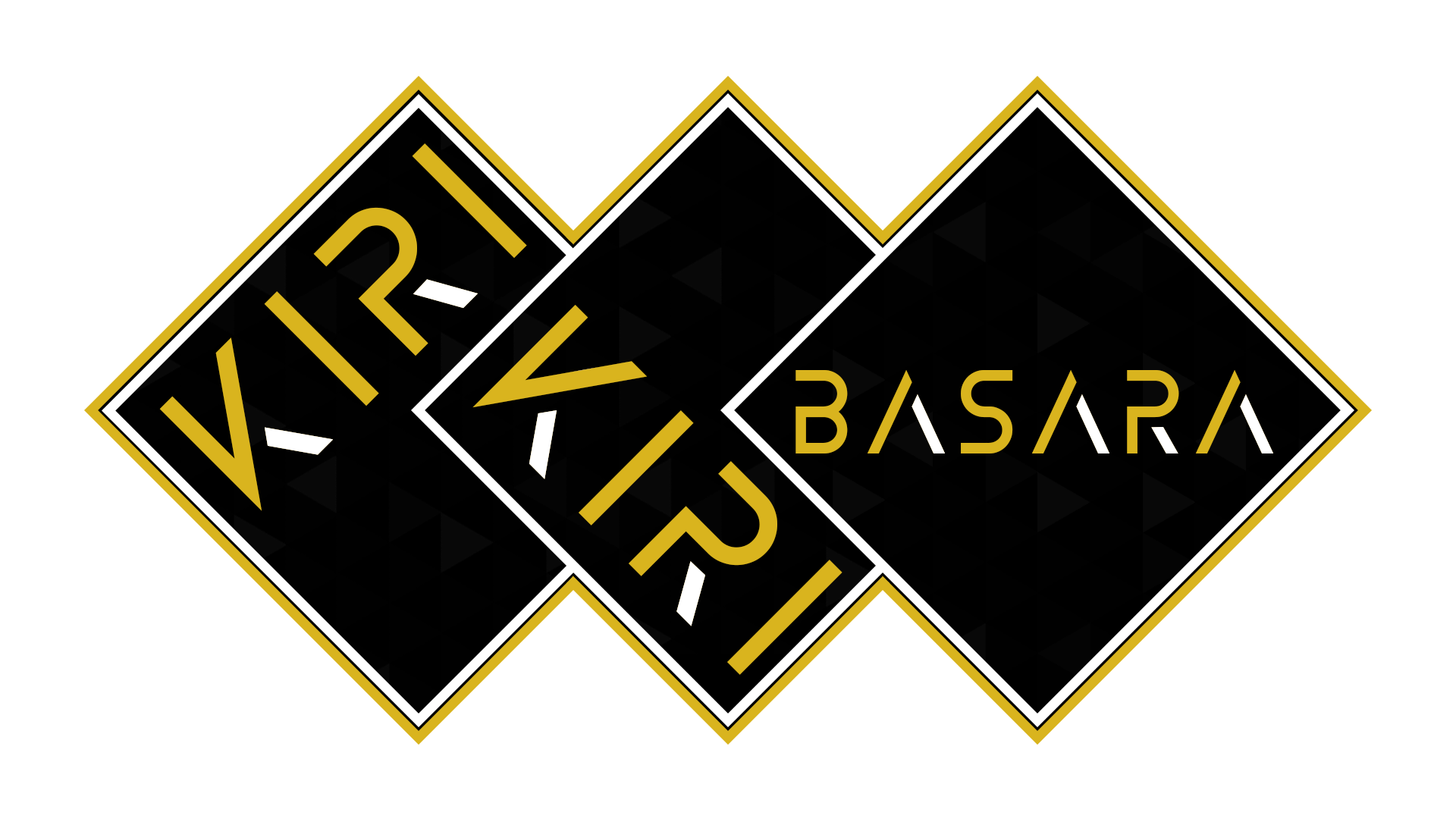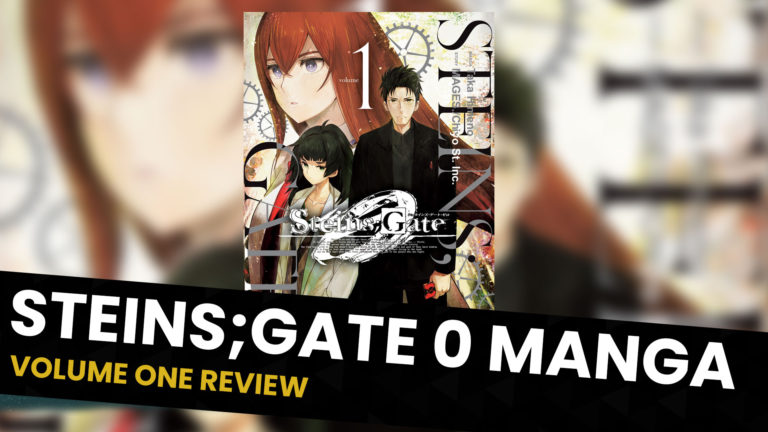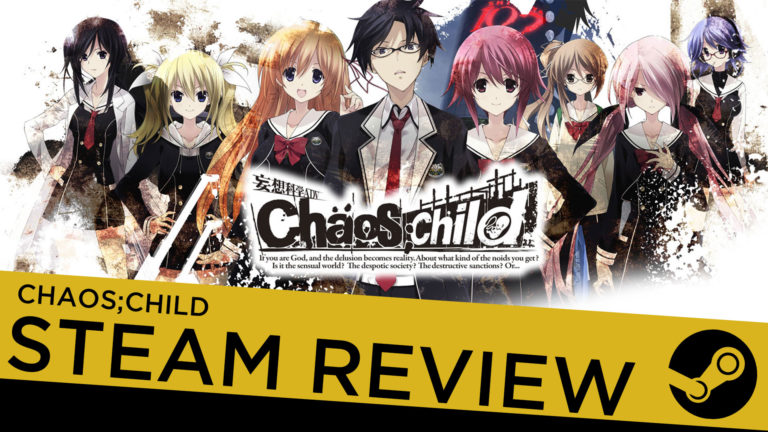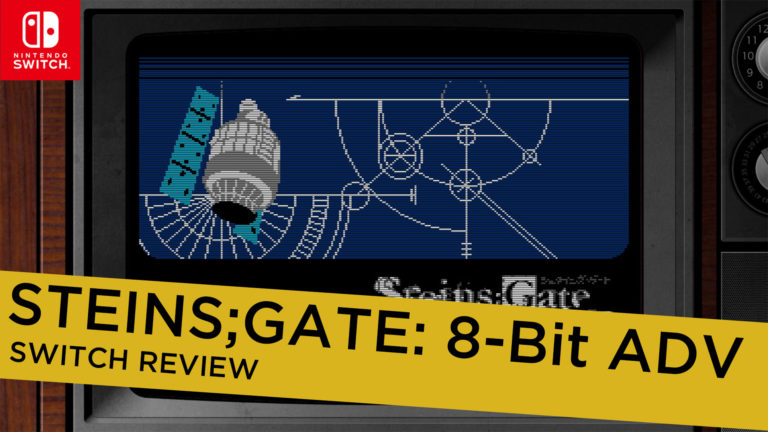ANONYMOUS;CODE. The myth, the legend, the phantom game that, for years, people doubted was ever going to come out. And who could blame them? The game was first announced over eight years ago in 2015, and was intended for launch in winter 2016 in Japan. Then the delays started.
Five years ago, when this very website was still in its infancy in 2018, my colleague Martin penned a speculation piece based on what we knew about the game then—closing it out with this charmingly optimistic sentence:
“We are looking forward to the release of Anonymous;Code sometime this year and hopefully we won’t have to wait for the English translation something like 5 years.”
Yeah, that aged well.
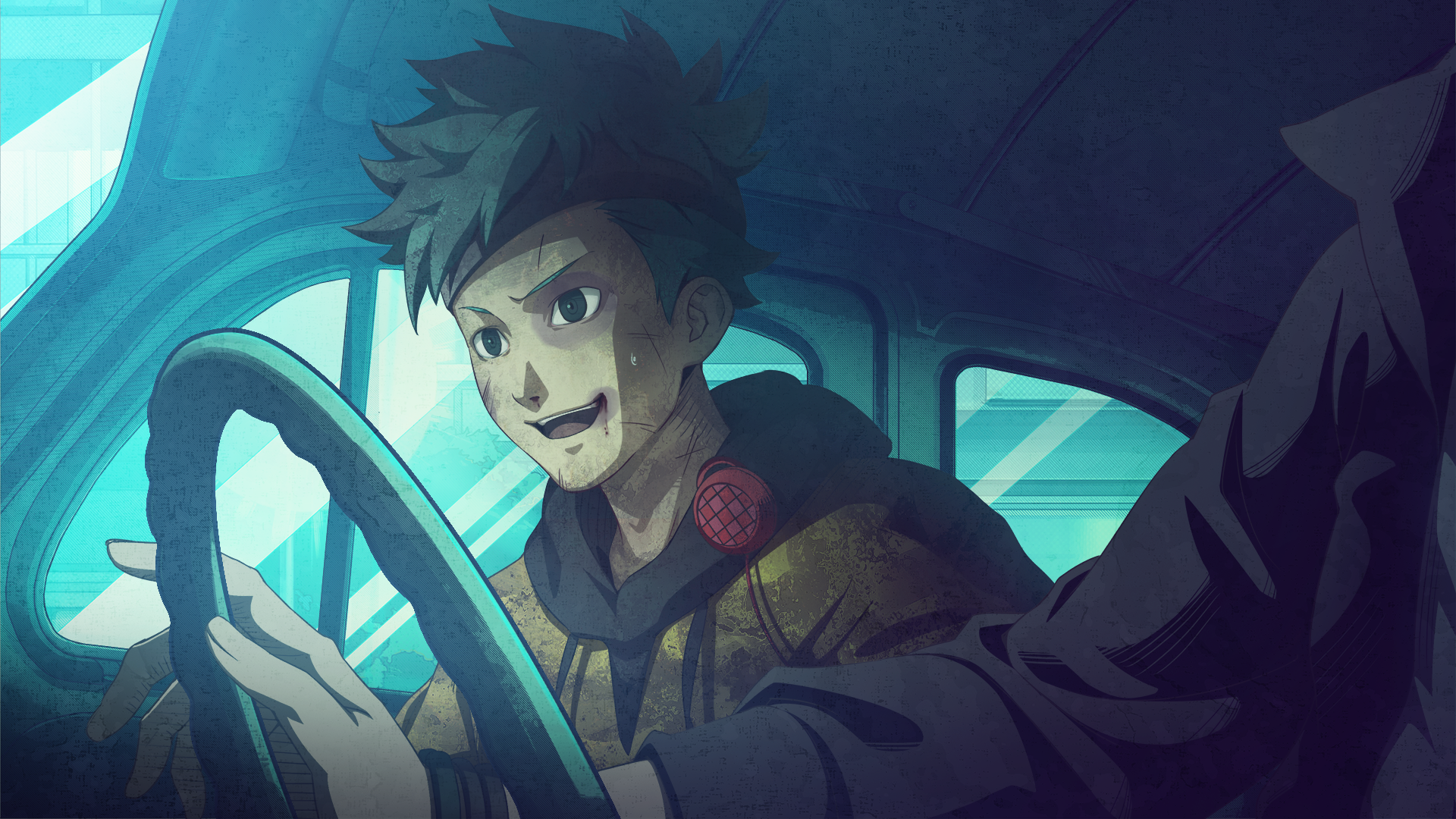
Behind the scenes, the SciADV series’s latest and most ambitious title was facing delay after delay, rewrite after rewrite. At some point, the question wasn’t “When’s it coming out?” anymore. At some point, that question turned into, “If it ever does come out, will it even live up to the hype?”
Time’s passed. In 2022, the game finally hit Japanese store shelves for the first time. Now, it’s September 2023—in just a few days, English readers will finally get to experience the sci-fi supernova MAGES. has been hyping up for close to a decade. And thanks to its Western publishers, Spike Chunsoft, I was offered the opportunity to give it an early overview and share my impressions.
So, back to my question. Does ANONYMOUS;CODE live up to the eight years of wait and hype?
Yes. The answer is yes.
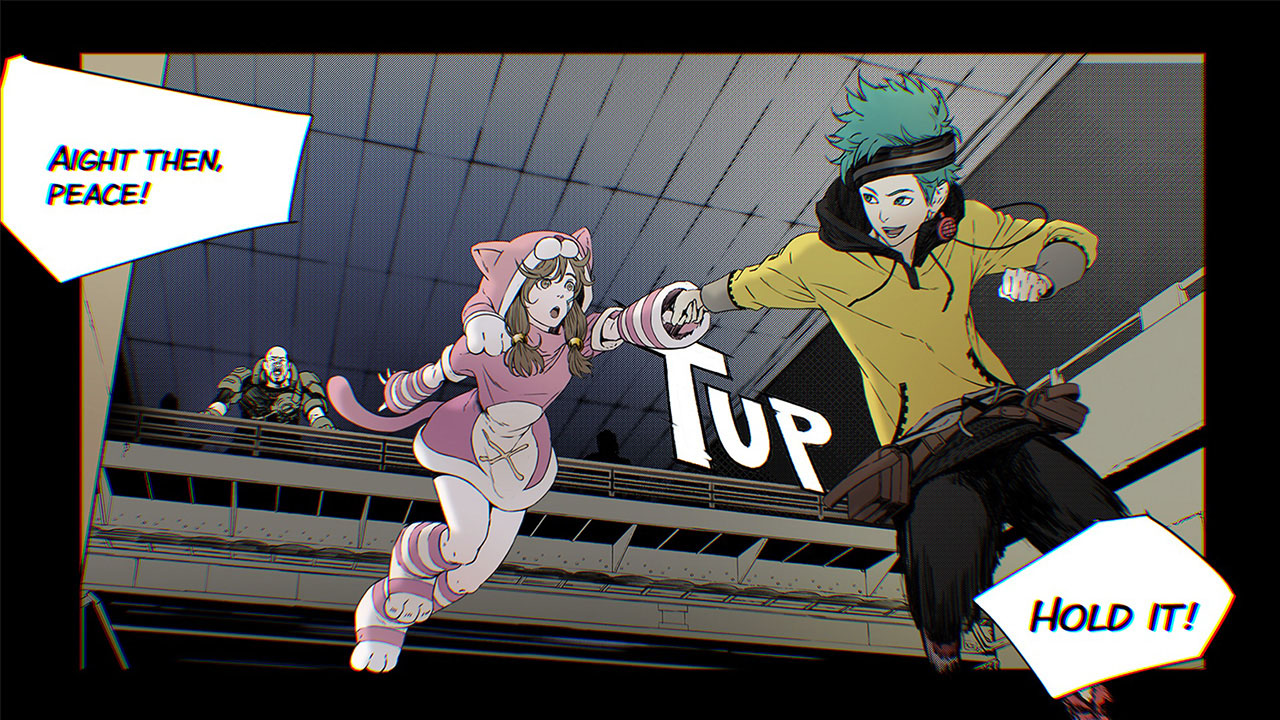
Our review today will cover a lot. For those who really like to get down and dirty with the deets, we’ve got you covered—but if you’re just interested in a section or two of info, feel free to jump around with the table of contents below.
All right, anons. Without further ado, let’s get right into the review.
Disclaimer: A review copy of ANONYMOUS;CODE’s digital deluxe edition was supplied to the author by the publisher; note that this provision has not affected the opinions expressed herein in any way.
Spike Chunsoft has confirmed that a Day One patch is planned for ANONYMOUS;CODE, which may affect some of the content discussed in this review.
Table of Contents
STORY
PREMISE IN PURSUIT
2037, Nakano. The Sad Morning has long passed, but its scars still haunt; a sore reminder of the tragedy. Millions were displaced or killed when spaceborne satellites simultaneously fired on the world in 2036, an earthly calamity spurred by wholly digital circumstances—namely, the Year 2036 Problem.
And yet, life goes on. For Pollon Takaoka, our young, dropout protagonist, this means making a living to survive in the aftermath, using the only skillset he’s got that’ll give him an edge: hacking. Make no mistake, though—Pollon is no malicious black hat. Together with his hacker pal and right-hand man, Cross, he’s formed a two-man team he calls “Nakano Symphonies.” Their creed: to help anyone who’s in need, no matter when.
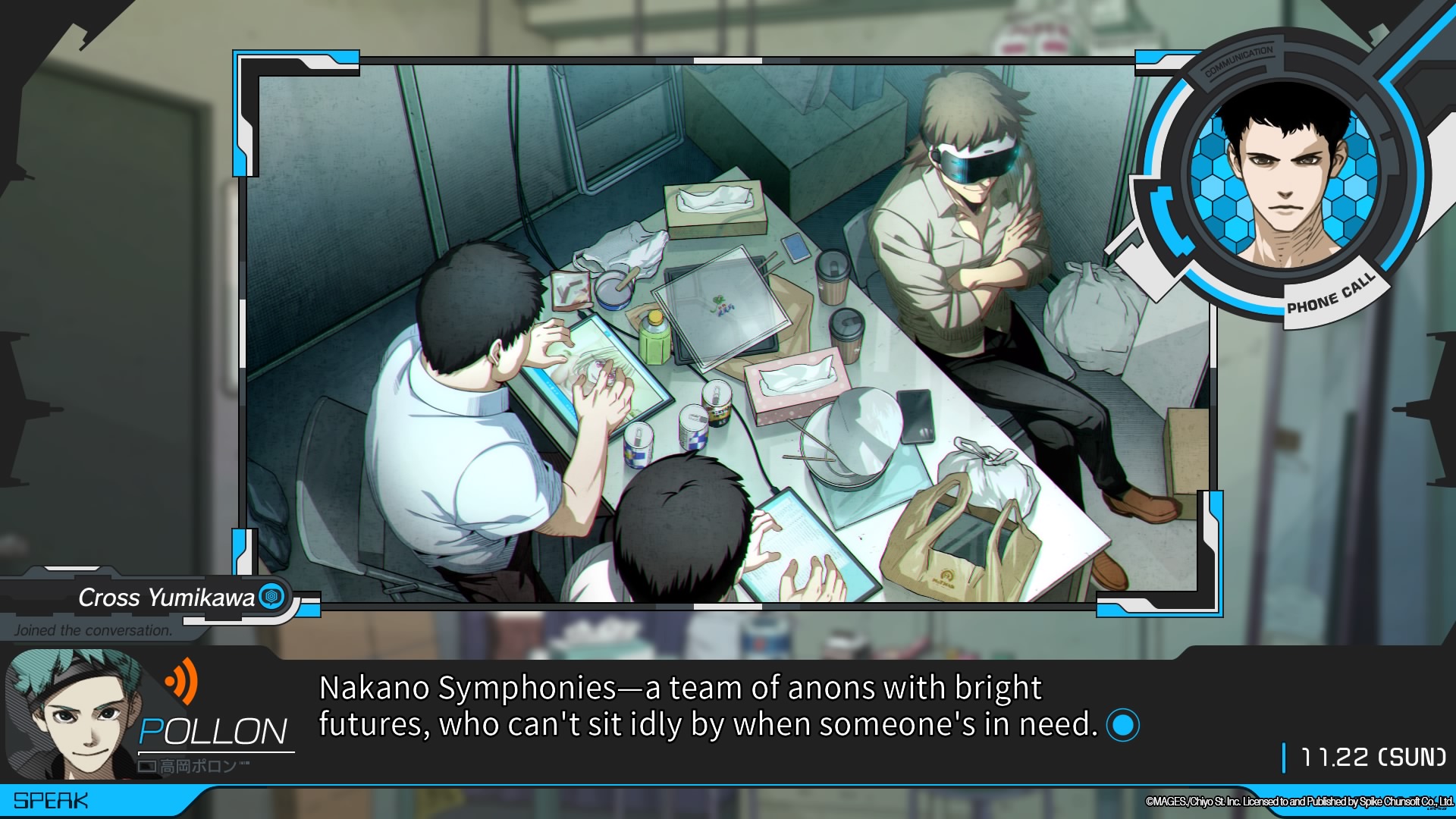
The Science Adventure visual novels have always been knee-deep in conspiracies, and on this front, ANONYMOUS;CODE delivers. Not long after the story begins, Pollon encounters a mysterious, catsuit-clad girl named Momo who’s clearly in need of help—somehow or another, she’s gotten the country’s military and the Vatican on her tail, desperate to capture her and whisk her away. So of course, where any reasonable person would falter, Pollon, foolhardy and justice-driven to a fault, swears to help her no matter the cost.
Thus begins a grand adventure on a monumental stage: to save Momo, to save hundreds of lives, and eventually, to save the world itself.
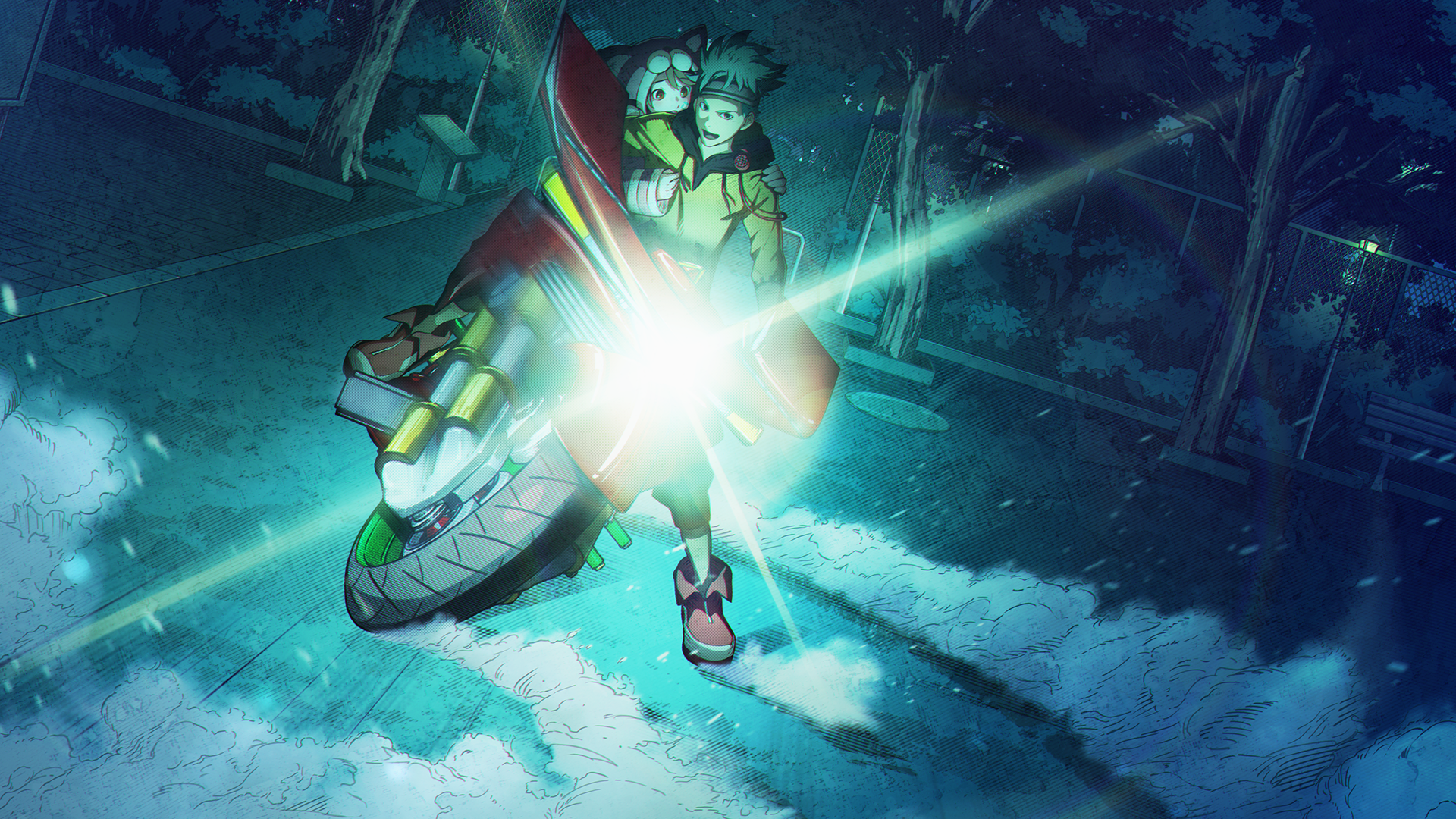
FUN, FAST, FRANTIC
It’d been admitted, prior to ANONYMOUS;CODE’s release in Japan last year, that the game’s story had been written and rewritten multiple times before it reached its current state. You can probably imagine the concern that raised. Had the game been rewritten so much because the story was in poor shape conceptually? Had it been rewritten so much in an attempt to bring it as close to perfection as possible? Perhaps a mix of both?
We don’t know much of what went on behind the scenes of this game’s development, but we can look at the quality of the story in front of us. And, let me not beat around the bush here—that story is damn good.
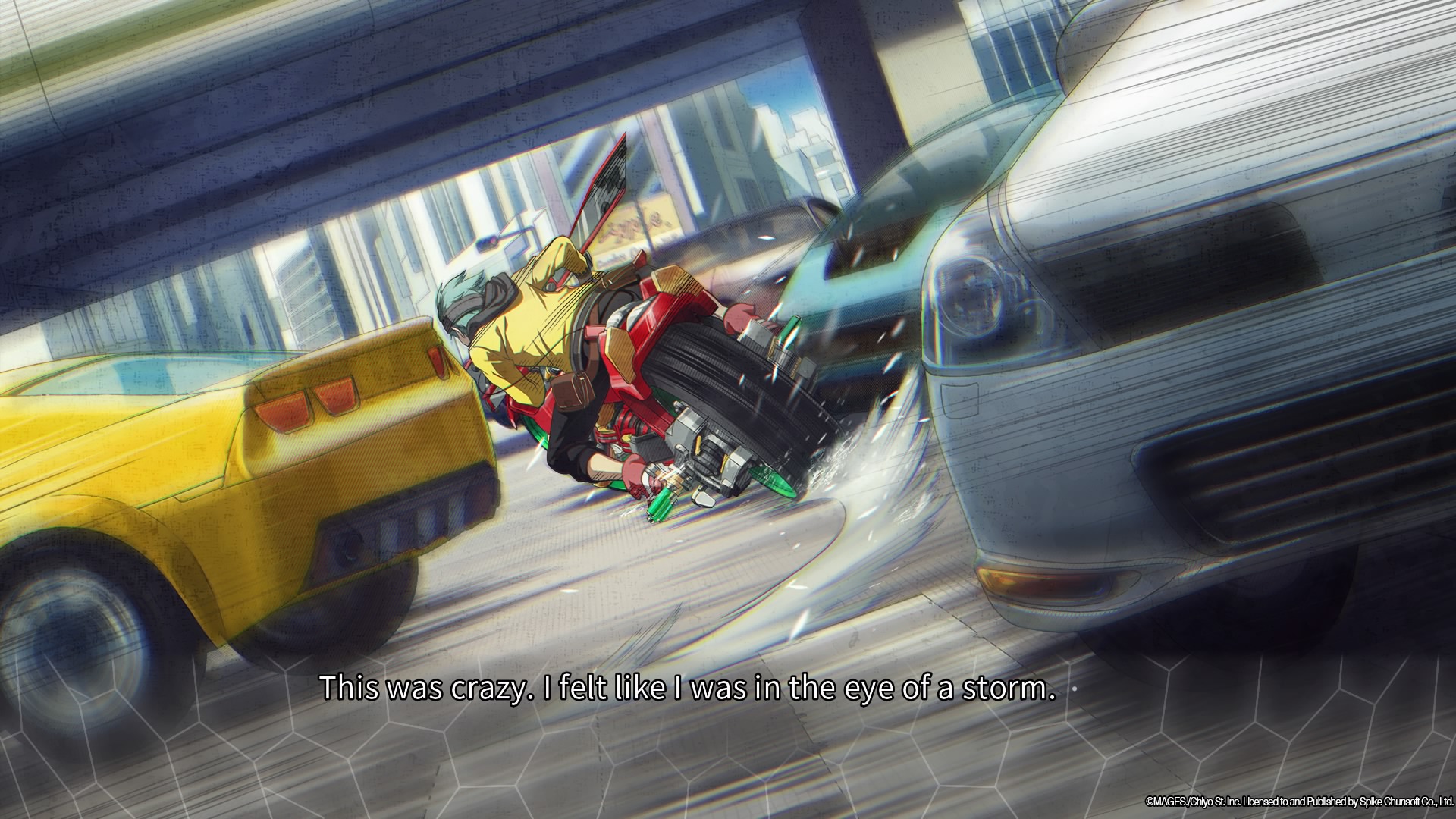
ANONYMOUS;CODE is fast, fun, and frantic. It’s got the classic Science Adventure formula, seamlessly weaving enthralling storytelling with fantastical sci-fi setpieces and lovable, down-to-earth characters. It’s really the shot in the arm the series desperately needed after the lackluster Robotics;Notes DaSH—which promised far too much, and went on to squander far too much of its runtime.
Hayashi Naotaka—of CHAOS;HEAD NOAH, STEINS;GATE, and ROBOTICS;NOTES ELITE renown—and relative newcomer Ayano Suehiro have delivered a tight, bulletproof narrative with ANONYMOUS;CODE. It promises to deliver exactly what it delivers: an impactful, powerful rollercoaster ride of action, emotion, and high-speed adventure. And for the more seasoned SciADV fans, there are layers upon layers of hidden meaning to uncover throughout the narrative. But we’ll get back to that later.
And yes, ANONYMOUS;CODE does take the world stage. It deals with older worldwide conspiracies, morphing and recontextualizing them to fit a futuristic world where quantum computers and Earth simulators take center stage. The Science Adventure series has always been good at blending the new, the old, and the strange, but ANONYMOUS;CODE takes it up a notch. What you’re seeing may not be entirely accurate, but it sure is fun as hell to follow.
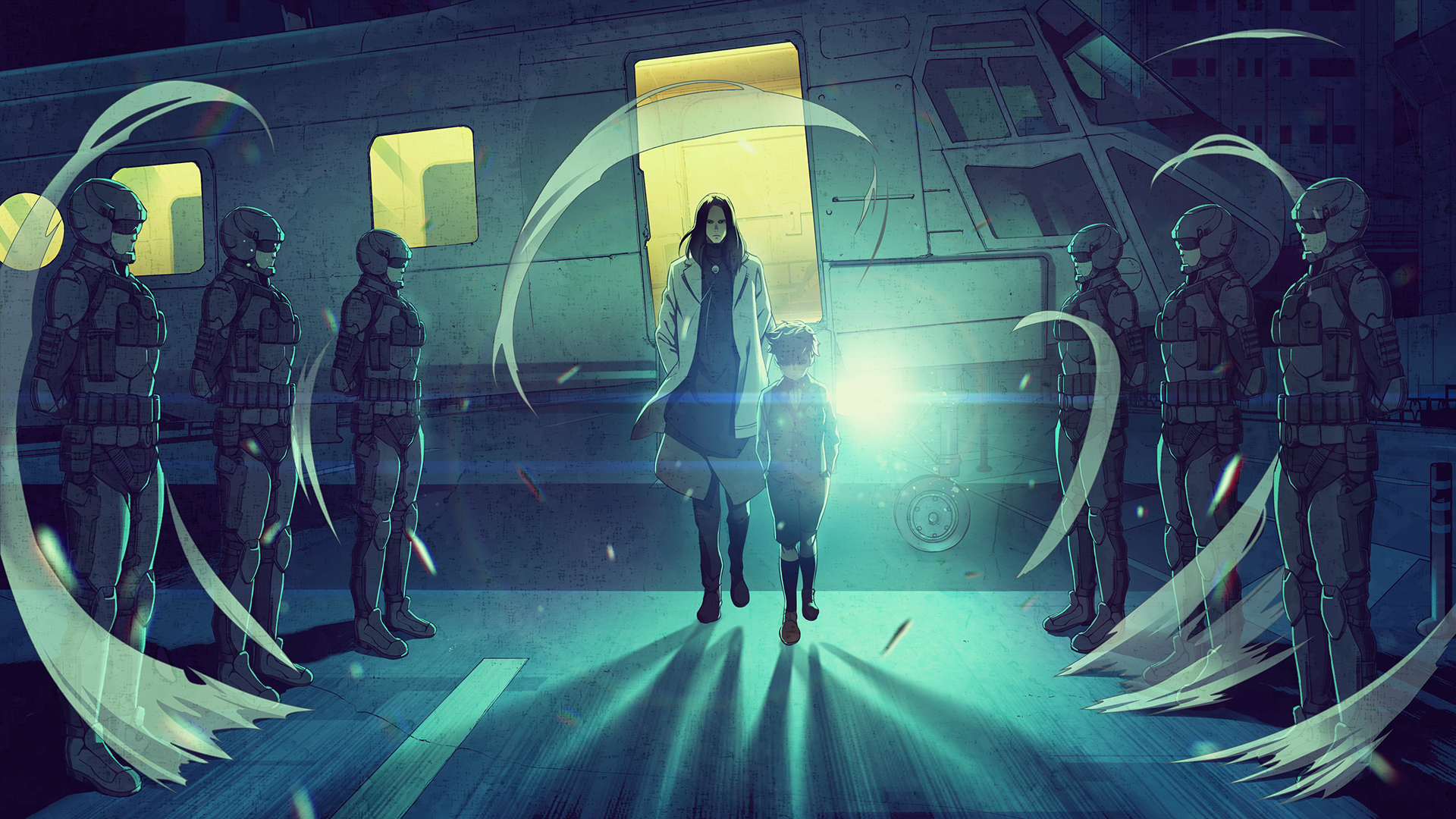
SYNTHESIS
Perhaps other SciADV games like STEINS;GATE have come to be known for their half-and-half structure: a calmer, slower first half that gets you comfortable with the world, characters, and mechanics of the game, before throwing it all into an emotional maelstrom of fast-paced action.
Where ANONYMOUS;CODE differs is that it tackles both halves at the same time throughout its runtime. There’s rarely a dull or wasted moment in this game, which is only too fitting considering its most prominent action theme is literally called “ACCELERATOR.” There’s almost always some goal, some life-threatening problem just hours away from wreaking havoc on the horizon, and the Nakano Symphonies never sit back twiddling their thumbs when someone’s in need. They’re always problem solving, attacking the issue head-on, fighting for those who need the help. To be frank, it’s practically impossible to be bored by this game.
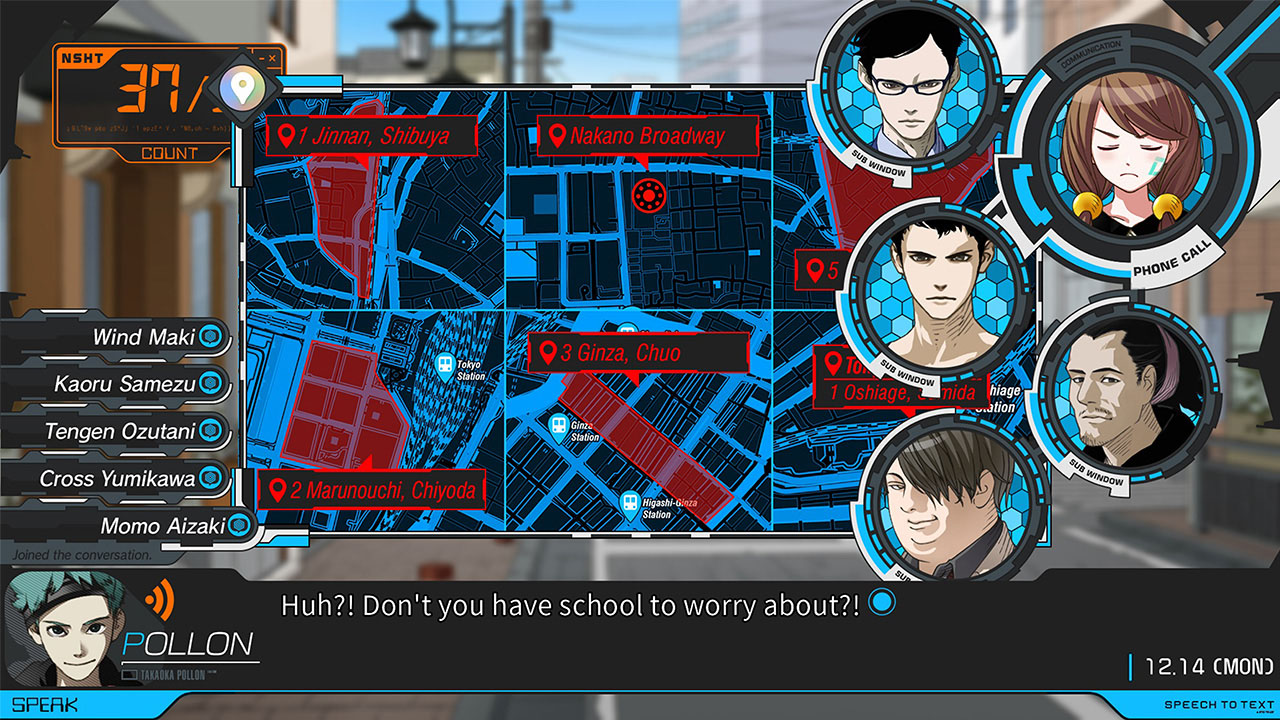
The flip side to this is that ANONYMOUS;CODE doesn’t often slow down. Other SciADV games like STEINS;GATE and CHAOS;CHILD arguably spend a lot of time on slice of life, hiding their mind-shattering twists and turns behind scenes of slower character- and plot-building moments. And that’s not to say that that approach is bad, because development is important context, and good characters make for good plot moments. But once you’ve got a taste of the action, it can be hard not to feel impatient for more when things settle down.
ANONYMOUS;CODE’s synthesis approach works. It never leaves you impatient for thrills, but nor is your connection to its main duo or the world made weaker for it. This is a game whose greatest qualities shine brightest in the action-packed arcs it throws at you like fastballs. In that sense, ANONYMOUS;CODE really evokes the classic SciADV feel while putting a new twist on the formula. It wears with pride the series’s strongest aspects—great character development, plot, and world-building—while engaging in its own, fresher brand of pacing.
(And in case you’re worried, I am exaggerating a little. ANONYMOUS;CODE isn’t always pedal to the metal. There are breaks here and there, slower moments that bridge the gaps and grow the characters outside of their struggles. These never feel like wasted time either—there’s just enough to satisfy before things kick off again.)
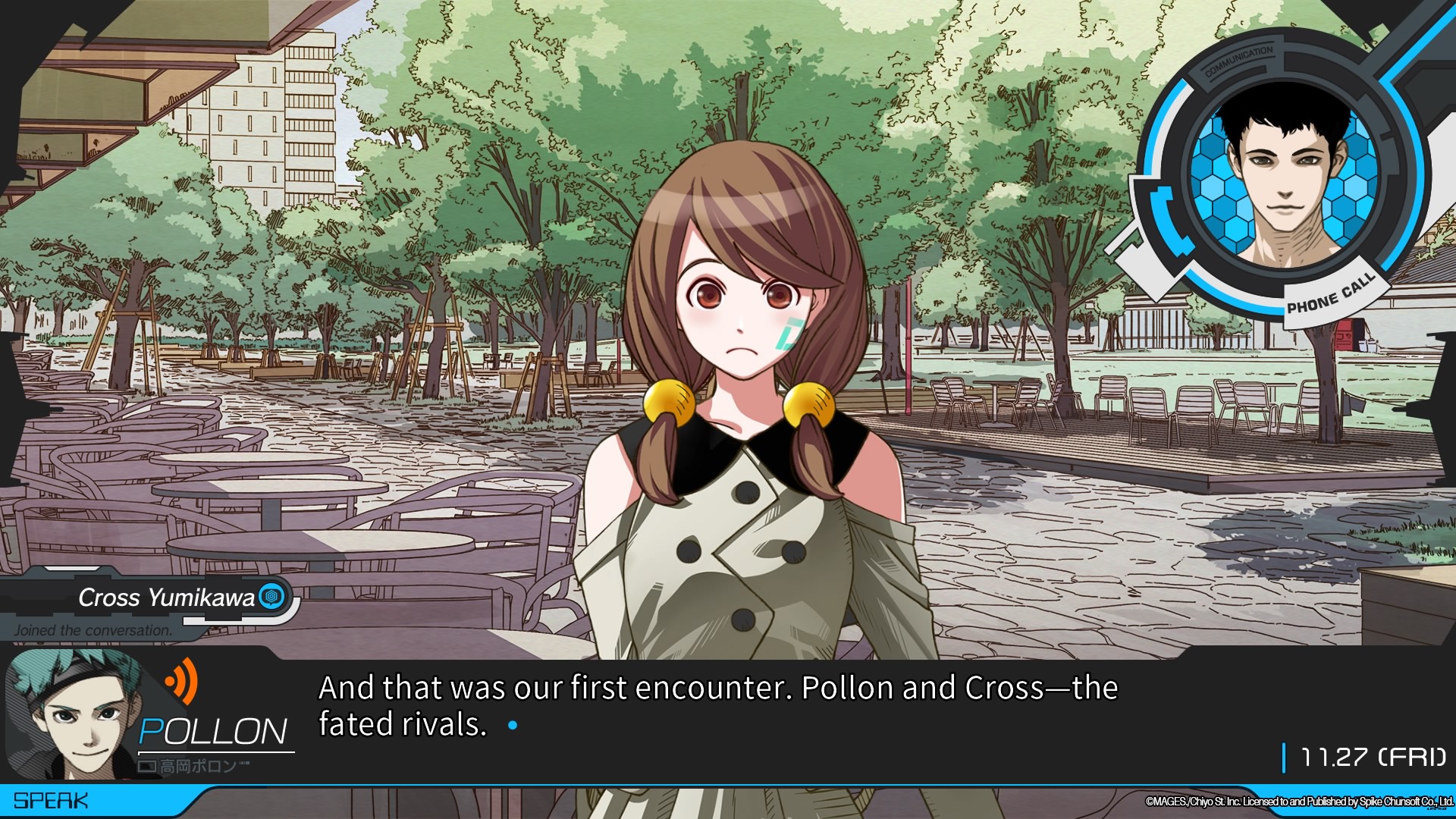
CHARACTERIZE
ANONYMOUS;CODE hits it out of the park with its twin protagonists, Pollon and Momo.
They’re deceptively simple by their premises. I mean, take one look at Pollon and you’d probably assume he’s just some annoying, cocky hacker kid. An immature brat, maybe, who doesn’t know much about how the world works and pushes too selfishly for his own desires.
Well, you’d be half right. Yeah, Pollon’s a cocky kid, but he’s more mature about it than he lets on. If you ask him, hackers the world over are douchebags, only doing what they do because there’s something in it for them. And, well, in the world ANONYMOUS;CODE, most of them actually are pretty self-centered. Pollon, on the other hand, doesn’t hack because he wants to, but because he has to—it’s how he can keep putting food on the table in a world still reeling from worldwide disaster.
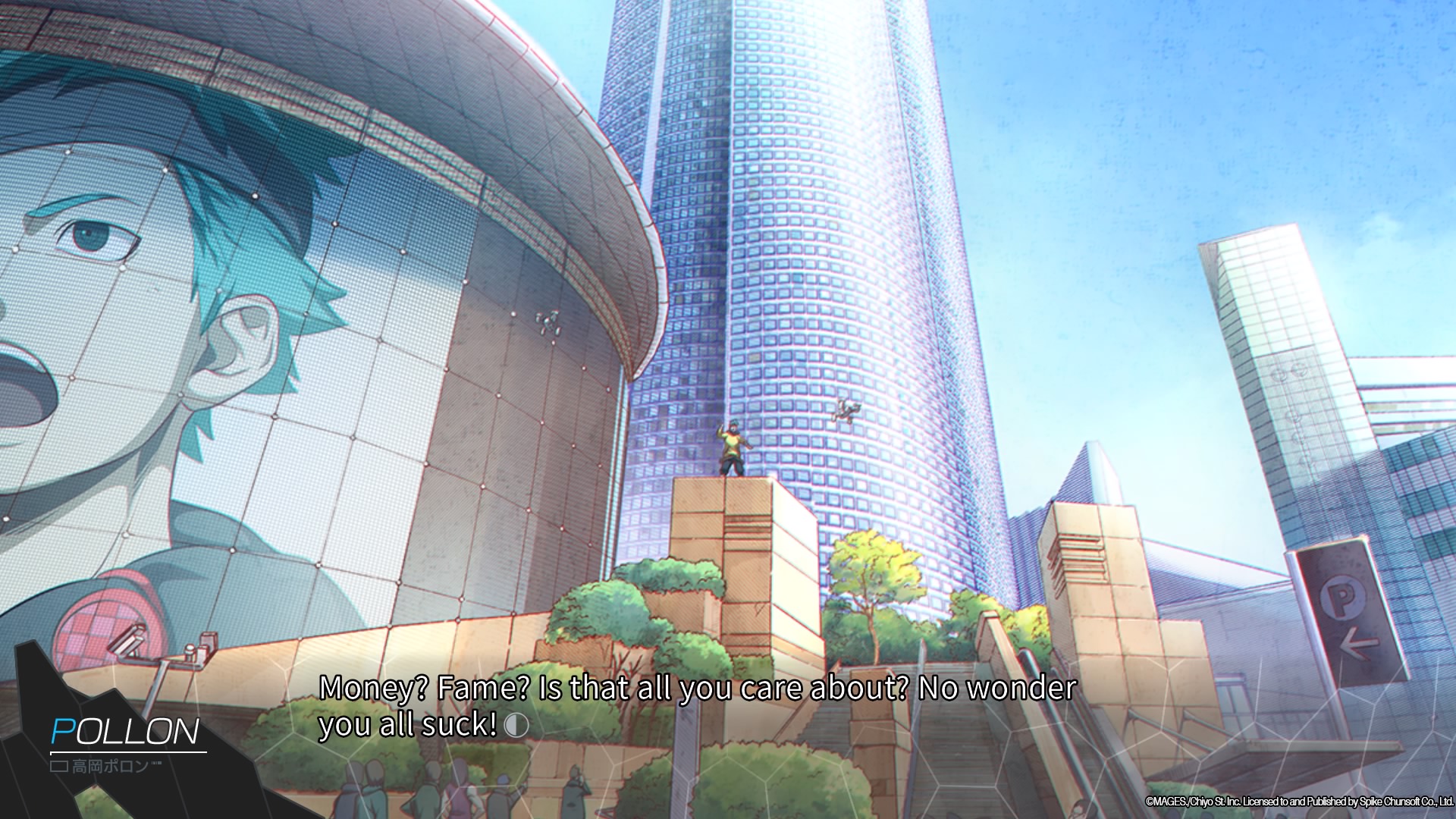
And so Pollon hacks. But even though it’s necessity that drives him, he always stays true to his creed during his hacker jobs: he wants to help people in need, and he’ll never sit idly by when someone needs help. So sure, he’s selfish about it; he pushes for the impossible, blind to the nuances of what’s considered reasonable, but he only does it because he’s selfish about being selfless.
It’s really quite the breath of fresh air to have a protagonist who’s just so utterly devoted to justice. And of course, things don’t always go quite as planned for Pollon—wouldn’t be a good narrative if it didn’t test him a bit, force him to redefine what it is he’s fighting for, right? ANONYMOUS;CODE gets to be a bit bittersweet in this regard, and I’m excited to see what others will think of Pollon’s growth.
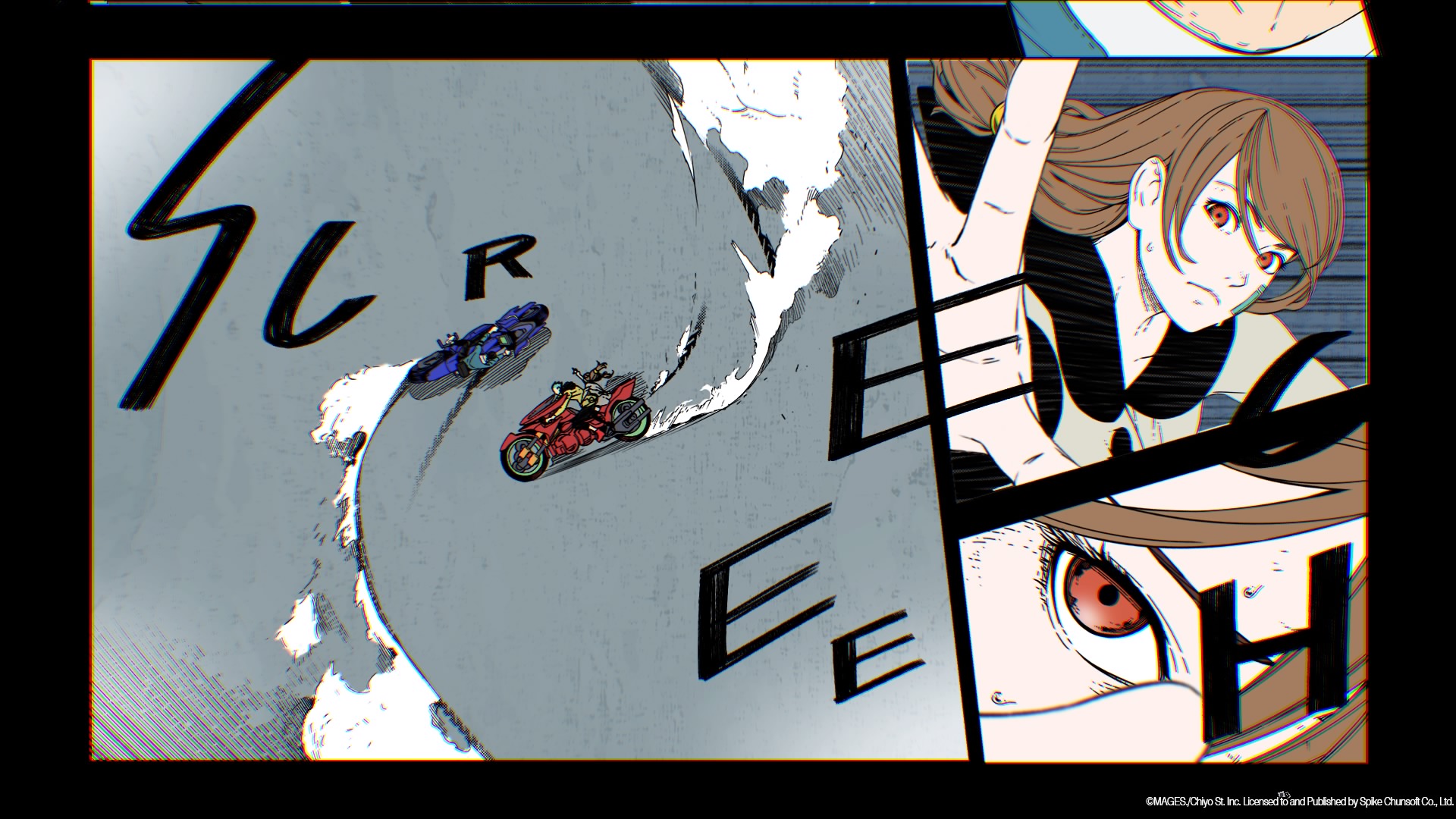
Then we have Momo. Poor Momo, who, for eight years, probably hasn’t really been taken all too seriously because the promotional material can’t stop showing her in that damn catsuit. Just to be clear here, the game spends maybe three hours with her in that catsuit—which she’s only wearing because of desperate circumstances—and then she gets a proper change of clothes and you never see it again (almost).
But okay, I digress. Momo is a marvel of a character. Like Pollon, she feels a strong responsibility to help others, driven by her own grim past. Her aspirations and will are hers, and hers alone. No matter how gung-ho Pollon is about trying to help her, she won’t open up to him—she can’t. She would rather bring closure to her troubles alone if she can, because no matter how desperately she needs comrades, she can’t bear to take the massively selfish step that is asking for help. Her task is simply that perilous.
Momo’s story does not begin with Pollon, and they are not immediately compatible. It is only through shared strife and trust, built up slowly, that their paths begin to intertwine—and when they do, oh, do they intertwine. As Momo begins to trust her back to Pollon, so too does Pollon trust his to her. They grow together, fight together, encourage each other to keep going when the going gets rough. Momo’s tale is one of anxieties, but it is also one of trust, inner strength, and a growing spirit to fight on for what’s right.

Together, Momo and Pollon earn their spot as one of the best protagonist duos of the series, standing toe to toe with my favorites, ROBOTICS;NOTES’ Akiho and Kaito—their arcs are reminiscent in all the right ways.
Pollon and Momo make up the most of this game’s perspective, meaning that they generally have the best and the most character development. Others, like Asuma, Tengen, and Bambi, get a decent bit of growth, but it’s clear to see from the start that the spotlight is on the two shooting stars.
I wouldn’t call this a negative point, though. While other characters can be fairly static, they tend to fill their roles perfectly. You can always expect Cross to be Pollon’s cool, reliable right-hand man, or Wind to be the surprisingly lovable nerd with the scoop, or Nonno to be the adorable little genius girl with great gadgets and funny phrasings.
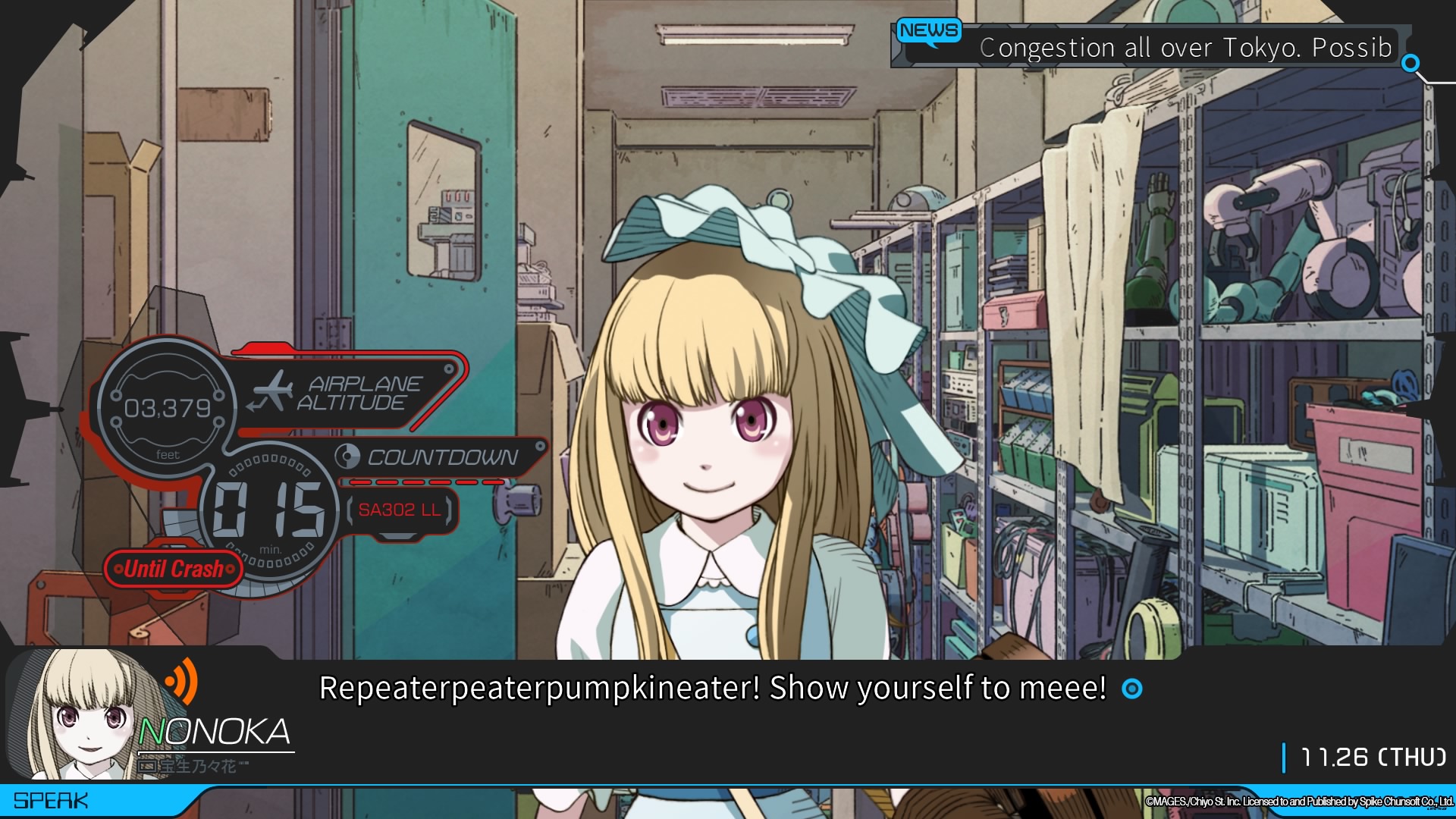
I’m not disappointed about this because, well, the game doesn’t give you anything to be disappointed about. From the outset, it’s pretty clear that this is Pollon and Momo’s story. ANONYMOUS;CODE never even begins to hint at character arcs it knows won’t fit its narrative structure, and I say, good for it. Unlike CHAOS;CHILD, which never knows what to do with some of its side characters but still foists unmemorable routes on them, ANONYMOUS;CODE smartly abides its limits. Less is more.
HOW LONG IS LONG ENOUGH?
Given its speedy pacing, ANONYMOUS;CODE cuts the fat, leaving behind only the juicy meat. I’d say this is to its benefit, because again, it’s extremely hard to get bored as a result. On the other hand, because the resulting story is not bloated, it’s not particularly long either. By my estimate, ANONYMOUS;CODE will take the average reader a bit under 30 hours to finish. For comparison’s sake, I’d place it around the length of STEINS;GATE’s intro to true ending, minus any side routes.
Is that a problem? Well, ANONYMOUS;CODE is priced at a steep $60 USD (albeit with a preorder/launch discount of 10% for consoles and Steam respectively), which is a bit hard to justify when you consider that most other SciADV entries are cheaper and offer a longer runtime.
If you’re interested but hesitant, the question you should probably ask yourself is, would you pay more money for less content, if less content were better than more?
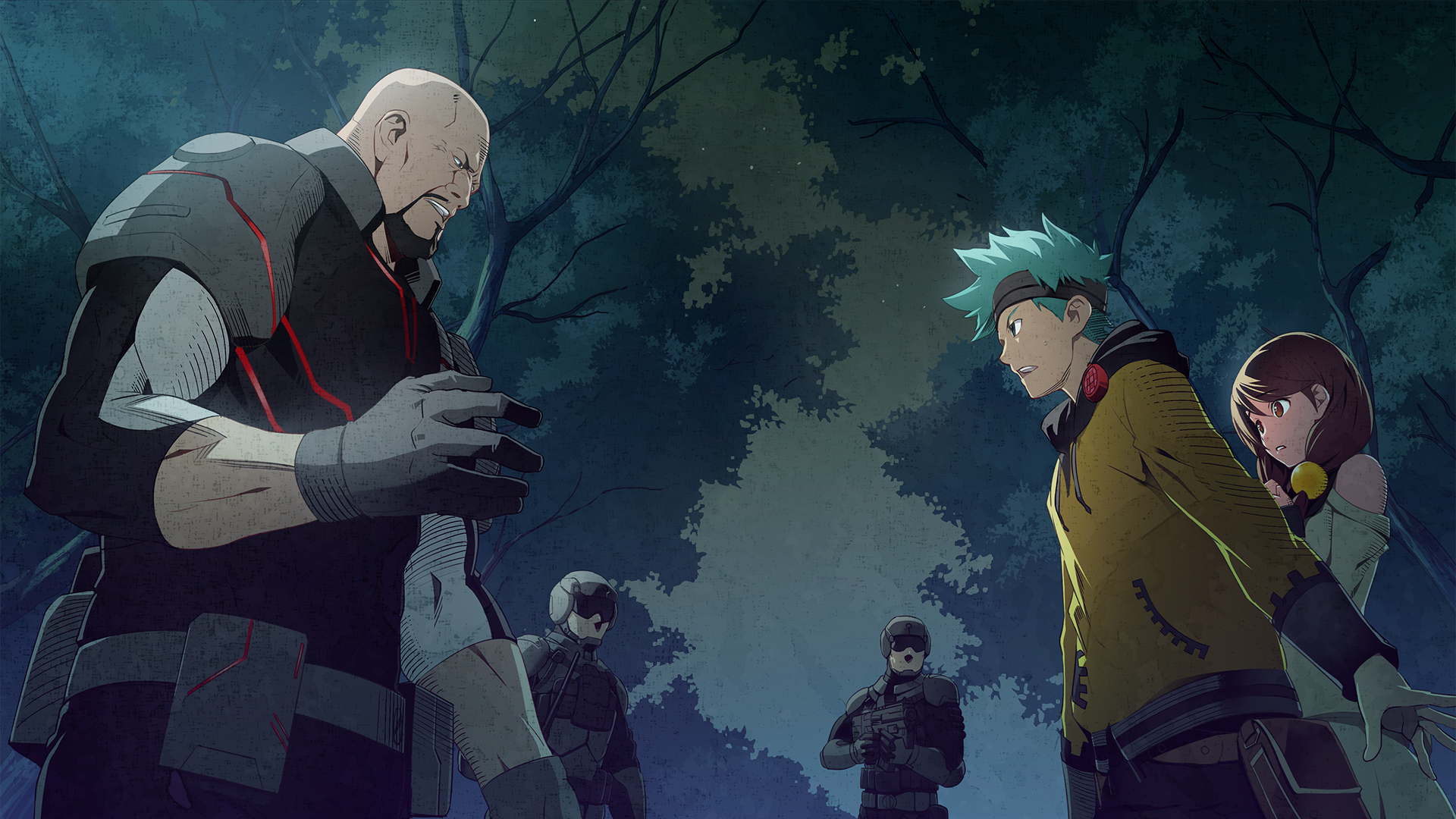
ANONYMOUS;CODE works so well specifically because it doesn’t bog you down with slower, more forgettable scenes. Heck, it doesn’t even bother with character routes, which were practically a series staple at this point. The game recognizes that splitting the narrative to different heroines would be to its detriment, because the one path it does follow is simply that much stronger in isolation; to add alternate routes would be to cheapen its value. So yes, while you do get less for paying more, what you get is top-shelf, prime material. Perhaps that’s worth the price of admission.
Still, $60 is $60, and $60 is the priciest a visual novel (and most video games) can get. Outside of committed SciADV series fans, or those with a strong interest in what ANONYMOUS;CODE has to offer, I can see this one being something of a hard sell.
SERIES, SCHMERIES...
Some of you out there might be new to the Science Adventure series. Maybe you’ve gone through one or two of the titles already and want to jump into something fresh and brand new. Or maybe you’re thinking about picking up ANONYMOUS;CODE as your first foray into SciADV. That begs an obvious question: do you need to read the rest of the series to play this game?
I’m going to say the answer is no—with an asterisk. ANONYMOUS;CODE is the latest entry in a fourteen-year-strong series, and so naturally, it’s going to pull on elements from the games that have come before. Still, if you’re willing to have an open mind—if you can look past a fair amount of wackiness that may not make complete sense to you yet—I would actually say ANONYMOUS;CODE is a decent enough starting point. There’s a lot here to love even if you’re not fully acquainted on what happened before Pollon’s adventure. However, I would also recommend checking out the rest of the SciADV series afterward, too. There’s a lot more to appreciate, both inside and outside of ANONYMOUS;CODE, when you’ve got more context under your belt.
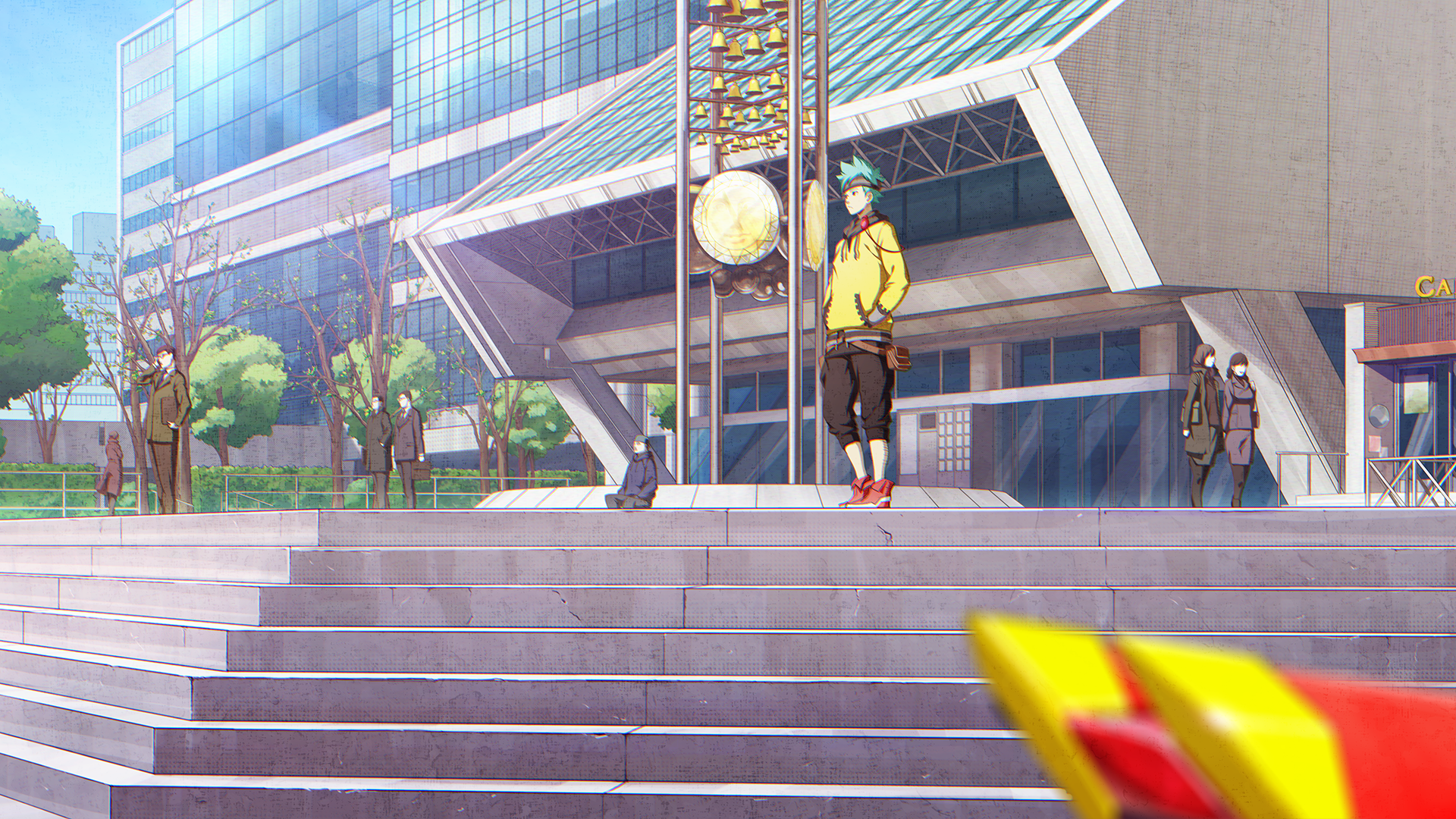
If you’re acquainted with just the STEINS;GATE subseries before you jump into ANONYMOUS;CODE, you’ll have things a little better than the complete newcomer. Many of ANONYMOUS;CODE’s mechanics are actually something of an extension of what the STEINS;GATE titles (the original, 0, Variant Space Octet, the movie, etc.) introduce. You should still expect some things not to make total sense, but overall, it’s not a terrible choice.
Now, if you want to be able to build a working understanding of everything that’s going on in ANONYMOUS;CODE without too many compromises, you’ll probably want to get these titles under your belt:
- CHAOS;HEAD NOAH
- The STEINS;GATE subseries (the original, 0, Variant Space Octet, the movie, etc.)
- OCCULTIC;NINE (anime and/or light novels)
But if you’re even the slightest bit committed to enjoying ANONYMOUS;CODE to the fullest extent possible, I want you to trust me on this—I recommend going through as much of the Science Adventure series as you can, and want to, beforehand. And I really mean that.
This isn’t a requirement by any means. For most casual fans and readers, you won’t need everything. But if you consider yourself a hardcore fan, or a hardcore fan in the making… trust me. Let’s talk about why.
THE END, AS WELL AS THE BEGINNING
A few years back, Chiyomaru Shikura, the foremost creative force behind the SciADV series, claimed that ANONYMOUS;CODE would be “the culmination of the Science Adventure series.”
I’ll be honest, I shrugged that one off. I didn’t really take it too seriously. Why? Because to be frank, Chiyomaru Shikura has said a lot of things about this series over the years, and not all of them have exactly come to fruition…
But this time, I’ll gladly, very gladly admit that I was wrong. Shikura was not exaggerating. When you read deep, real deep into what ANONYMOUS;CODE tries to say… yeah, this is it. This is the new convergence point, the juncture where SciADV comes together—subtly.
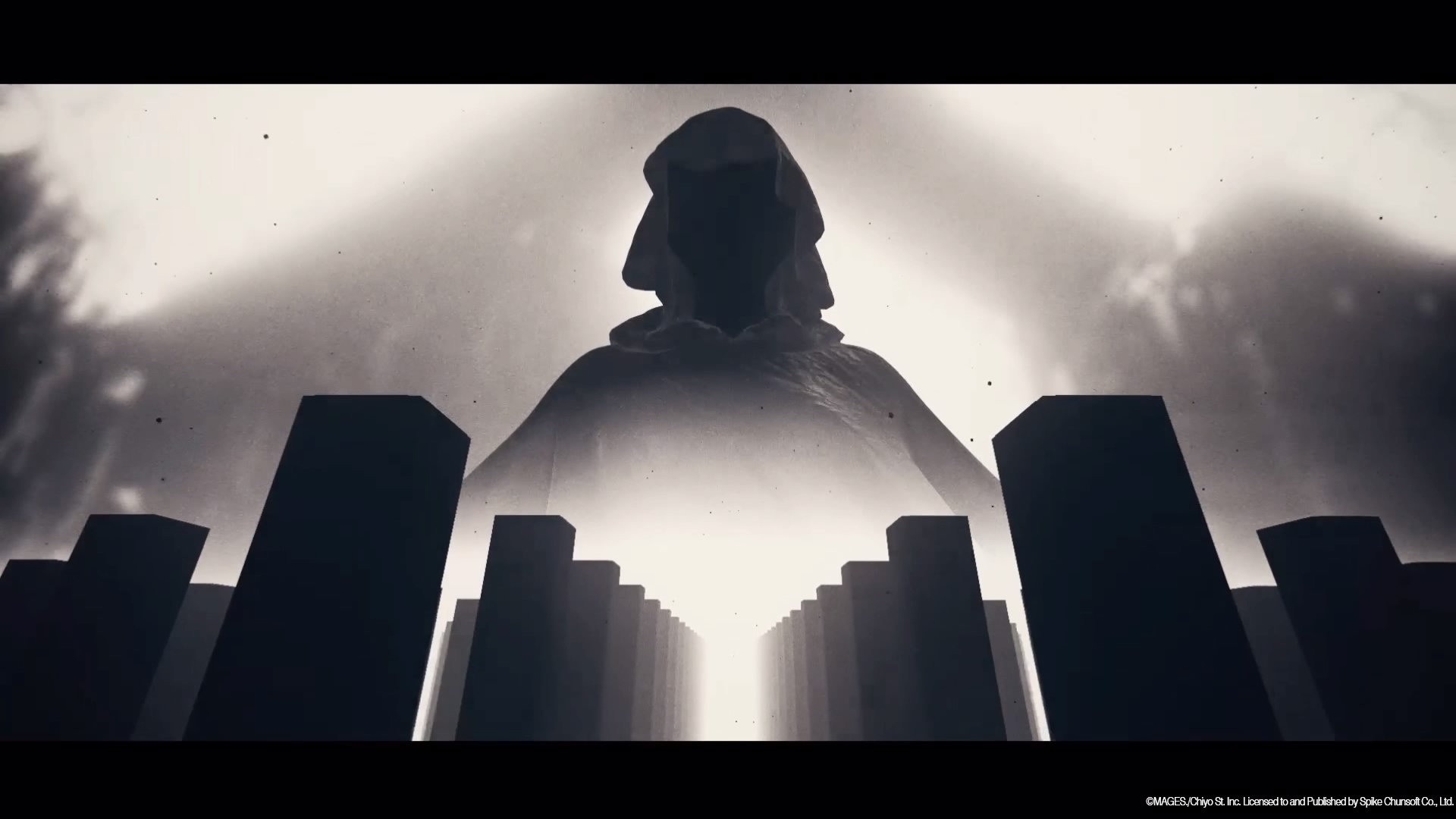
If the Science Adventure series is a tapestry, then ANONYMOUS;CODE is the unifying silver thread woven through it. It’s thin, very thin—hidden in plain sight. Yet, it spans the length of the tapestry; it’s the single piece holding everything together. And once you’ve observed that thread… you can never go back. This changes everything.
The most mindblowing thing about ANONYMOUS;CODE’s role in the series is, when you actually look back at the older titles in the series, you’ll start to realize that there were hints everywhere. Even as far back as the first entries, CHAOS;HEAD NOAH and STEINS;GATE, MAGES. was planning for this, building up concepts in the background to come back to later. The way they went about it was so subtle that, even if you had guessed at the truth, you’d still have thought it was just a crack theory, something too ambitious and too finely detailed to possibly be true. But the hints were there.
To be clear, ANONYMOUS;CODE isn’t the SciADVengers-esque culmination. The protagonists of every game aren’t going to show up at the end to fight the big bad. Instead, the way ANONYMOUS;CODE ties the series together is quieter—more on the subtler, mechanical level. A surface read will let you enjoy what the game offers at face value; but a deeper dive into it, and everything that came before it, will be the key to the SciADV universe.
The implications are startling. This is the end, as well as the beginning.
LOCALIZATION
I’m happy to share that, aside from a few caveats, ANONYMOUS;CODE has shaped up to be one of the Science Adventure series’s best English localizations to date. It’s almost a dream going through this game after the more troubling CHAOS;HEAD NOAH and ROBOTICS;NOTES localizations. Spike Chunsoft has pulled together some of the best for this project, including Andrew “Steiner” Hodgson—a longtime series fan, a translator on the stellar STEINS;GATE localization, and a—if not the—foremost expert on the Science Adventure series in the English-speaking sphere. The results just speak for themselves.
WRITTEN MAGIC
ANONYMOUS;CODE’s English script is confident. Whereas previous localizations may have struggled with natural writing, language nuance, and character voice, this release is lacking in nothing. It’s easy to get sucked into what the translation team has carefully crafted here—you’d almost forget that this is a translated game to begin with.
Take Pollon, for instance. His perspective covers the vast majority of the game’s runtime, and for that reason, it’s critical that his character voice is on point, reflecting who he is down to the subtlest details. ANONYMOUS;CODE’s localization never drops the ball in this regard: Pollon is smart, funny, and endearing. His speedy intuition, his passion for justice, his emotional highs and lows are rendered perfectly, never lacking in subtleties, and aided further by an on-point dub performance.
The same goes for any ANONYMOUS;CODE character. You’ll never doubt that Oz is the old-timer with a lot of crazy theories to share, that Nonno is the childish genius with the cutest rhymes, that Bambi is the policegirl with her eyes fixed on justice—because the localization captures all of these nuances flawlessly. Nor are the depths of the world itself obscured, either. Even the most technical of explanations are handled with surety.
When things go this right, it’s easy to take it for granted. This is the meticulous care ANONYMOUS;CODE deserves, because it’s the very same meticulous care its original creators meant for it back when they first built it up from an idea. My hope is that the success of this localization will be taken to heart, not for granted, and that future projects will continue to employ similar levels of careful and confident attention.
VISUAL WONDER
The world of ANONYMOUS;CODE is brimming with a wide range of visuals with text, ranging from on-screen news tickers, to in-universe webpages, to dynamic manga segments. It’s almost unbelievable how many, and how well these graphics are presented in English—especially coming off of the “anime subtitle” effect of some previous releases.
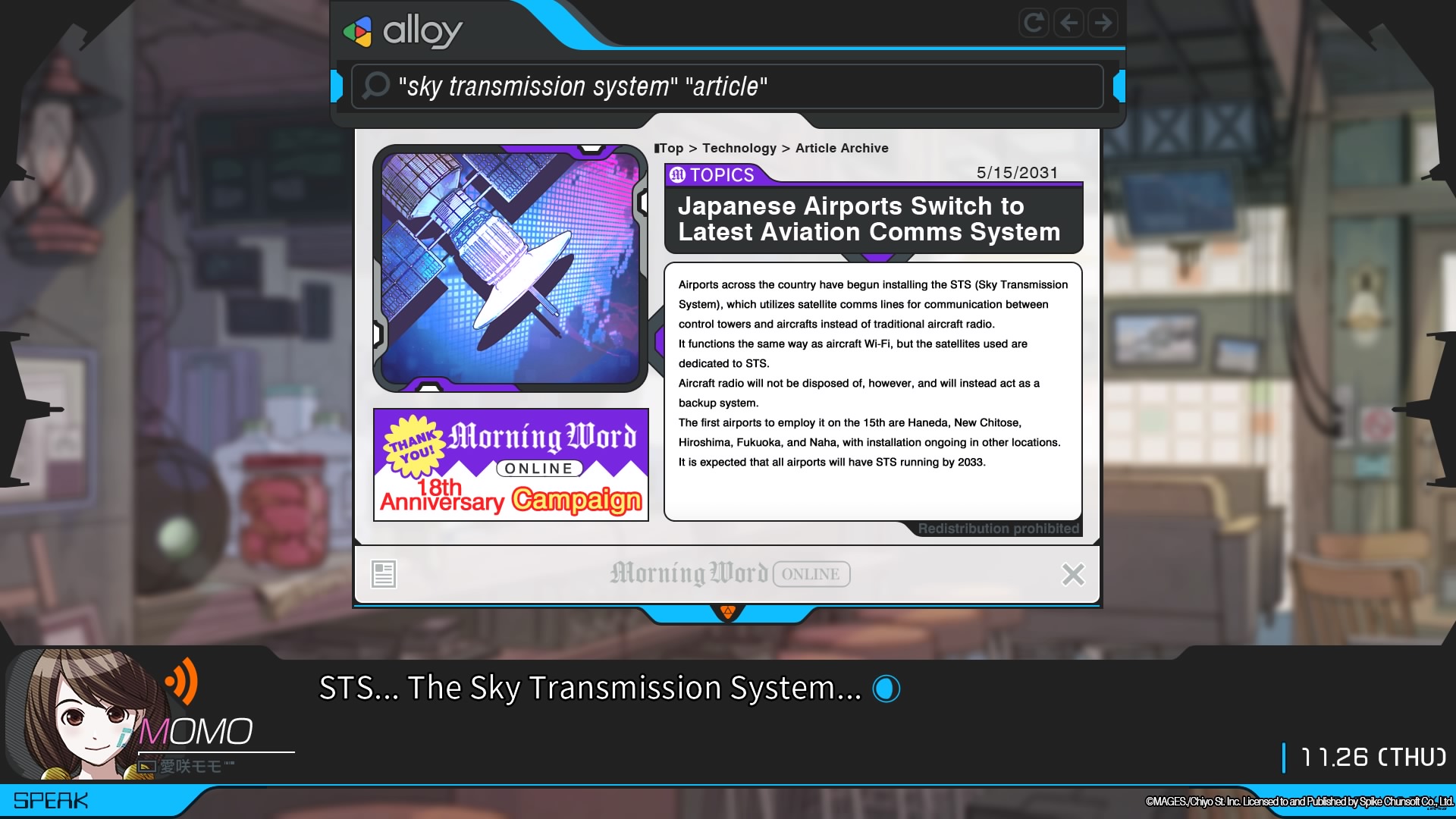
Given how integrated many of these visuals are in the storyline—with some even expanding on the universe in new ways—it’s great news that these were covered with care. Past releases have had issues where in-game ads, posters, and other miscellanea were left untranslated because they weren’t critical to the reader experience. And that’s not to say that every bit of visual miscellanea is translated in ANONYMOUS;CODE, but the majority is, and that does wonders for creating content parity; you can rest assured that, for the most part, you’re getting the same immersive experience in English that Japanese readers got with the original product.
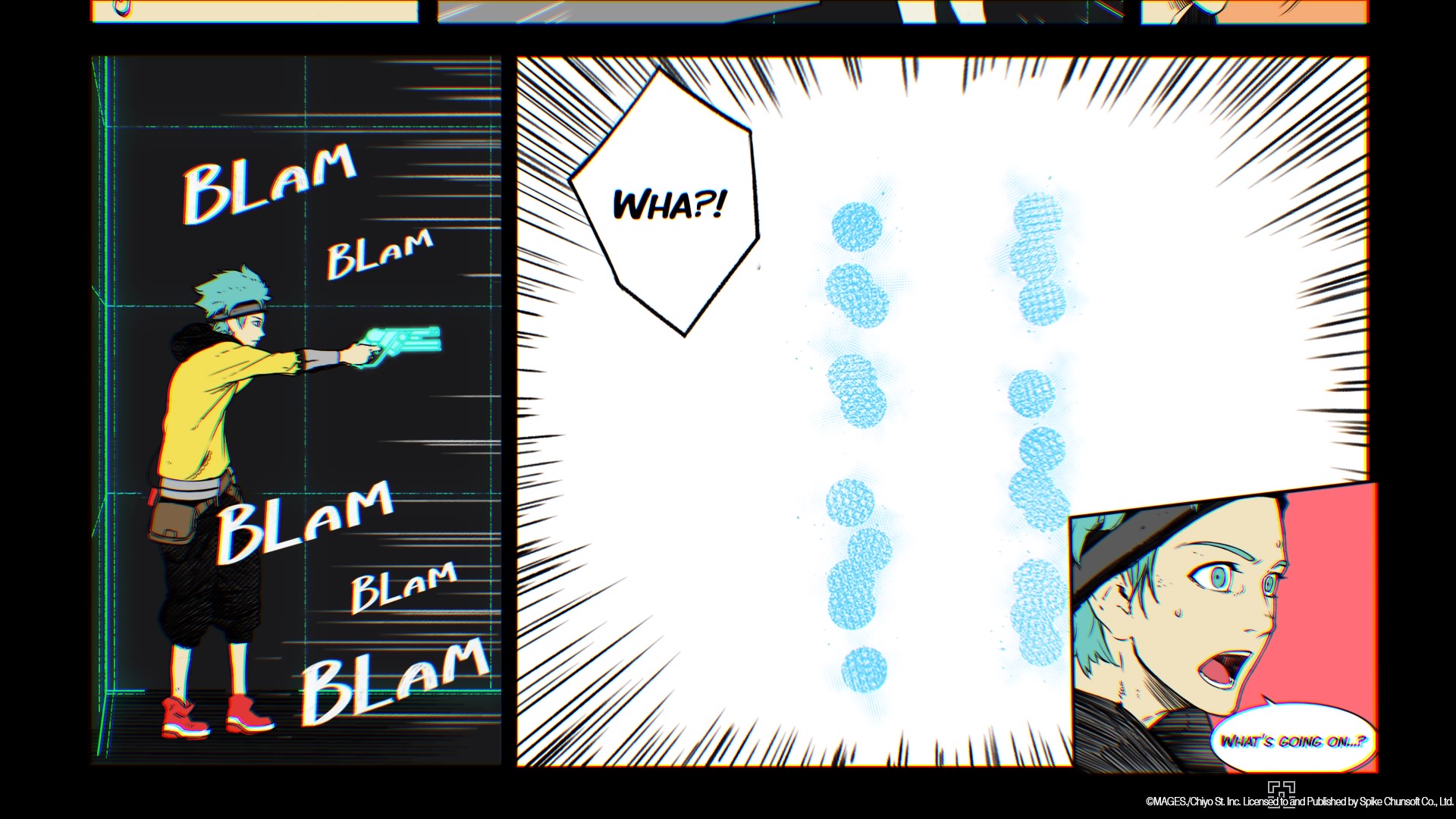
LOUD AND CLEAR
ANONYMOUS;CODE marks the first time a Science Adventure game has received an official English dub. And I gotta say, this is one hell of a first attempt.
I had played ANONYMOUS;CODE’s Japanese release to completion prior to picking up the English release for review. I was already familiar with the Japanese voice actors’ performances, and I was eager to hear how their English counterparts measured up. Right off the bat, I could tell the English translation team had really made some standout choices: Max Mittelman’s Pollon is confident, cocky, but not without wide emotional range; Anairis Quiñones’s Momo is comforting and strong; Yung-I Chang’s Cross is always cool and collected—the list goes on.
I know most SciADV fans are used to the Japanese voices by this point, and for that reason, the Japanese voicetrack may turn out to be the preferred choice for many. It’s a perfectly reasonable choice, of course, because the Japanese performance is also quite stellar. But if you’ve got even the slightest interest in the dub, let me be 100% honest: having listened to both tracks, in my opinion, the English dub absolutely stands toe to toe with the Japanese—sometimes, it even surpasses it. Mittelman’s perfectly natural, widely expressive Pollon comes to mind; it’s almost like he was born to play him.
Players might also want to consider the dub for the sense of immersion it introduces. If you’re not fluent in Japanese, you’ll be spending a lot of time looking down at the game’s textbox to know what characters are saying. But with the dub, oftentimes, you can simply watch the characters talk through a discussion, hearing what they have to say without needing to glance down at the textbox too much. This is crucial QoL for this game, because quite often, the characters will actually shift expressions or poses midsentence to match what they’re saying.
There was really only one downer I came across with the dub. Aside from the opening song “GAME OVER” (sung in English by longtime series vocalist Kanako Ito), neither the game’s insert song, nor its two ending songs are dubbed or subbed into English. Their (excellent) lyrics will unfortunately be lost on the English reader regardless of their voicetrack preference.
All in all, ANONYMOUS;CODE’s dub is a treat of a first venture into SciADV game dubbing. I’m especially hopeful that this trend will keep up with future releases as well.
CHOICES ARE GOOD, BUT...
Those who would prefer to play ANONYMOUS;CODE with its original Japanese voicetrack are in luck, but only sort of… It’s a choice you have, but it comes with diminishing returns.
The Japanese voicetrack itself is quite good. You can’t go wrong with these voice actors, and you might even recognize some them from previous SciADV games. For instance, Kaoru Samezu is voiced by Youji Ueda, who also played Alexis Leskinen in STEINS;GATE 0; and Bambi Kurashina is voiced by Ayano Yamamoto, who also played Nae Tennouji in STEINS;GATE.
Unfortunately, the Japanese voicetrack’s integration in the international release brings about its own set of issues. ANONYMOUS;CODE features brief scenes, every chapter or so on average, where characters speak, but there are no subtitles on-screen to match. For instance, a character might be speaking over another character, but since Pollon isn’t paying attention to them, that character’s speech isn’t reflected in the textbox. Or, he might have a brief flashback to past events, and while you can hear what the characters in the flashback are saying, there are no subtitles attached to them.
In the dub, this is less of a problem. You can actually hear what these characters are saying in English, and while it would be nice to be able to read it, too, at least you can understand what’s going on. On the Japanese voicetrack, though, you’re going to be lost, unless you happen to know enough Japanese.
This problem is at its most egregious when it comes to denied Loads. Throughout the game (and as shown in the videos above), you have the option to press a button to indicate to Pollon that he should Load a Save he’s made and return to the past. You can press this button anytime you want, but Pollon will only listen to you if he also thinks it makes sense to Load. If he doesn’t, he will actually speak a line where he denies your suggestion, and often, the line he speaks is directly related to what’s currently happening in the story. There are possibly hundreds of these voicelines that, in the Japanese voicetrack, are not subtitled or conveyed in any way to the English reader.
I’m not really sure why these parts of the game lack subtitles—maybe it was an engine limitation, or maybe it’s a genuine oversight. At any rate, it’s a pretty crummy situation for Japanese voice players. The only alternative those players will really have is to load an earlier save or autosave, then swap the voicetrack to English, then skip to the unsubtitled voices so they can understand what was said. Swapping voicetracks is pretty easy, but everything else about this situation is far from ideal. If you can look past this problem, though, for the most part, there’s not much else for sub players to worry about.
ROOM FOR IMPROVEMENT
ANONYMOUS;CODE’s localization is, on the whole, extremely good. I feel I should reemphasize this, because while I’m about to discuss some smaller issues with it, they are just that—small.
The game lacks italics. This isn’t necessarily a problem in itself; other Science Adventure translations have lacked italics too—perhaps due to engine limitations—and have used alternatives, like all caps, to work through the problem. But ANONYMOUS;CODE’s lack of italics hurts most as it relates to a particular puzzle toward the end of the game. Without spoilers, the Japanese release uses emphasis marks over the puzzle’s related text to alert the reader to the fact that they may need to do something there. But in the English release, since the equivalent italics aren’t used, that alert is less prominent, and it can be slightly harder for the reader to figure out how to proceed. (Not to worry—our 100% guide covers the solution.)
While the translation is generally very well written and edited, I do find that its use of the past perfect tense is somewhat lacking—sometimes it’s used where it’s needed, and sometimes it’s missed. This can lead to confusion about if an event that’s mentioned in the narration occurred prior to the narration, or is occurring at that very moment. This isn’t usually a big issue, but I do hope it can be ironed out for future releases.
There are a few instances of recurring series terminology that are inconsistently translated within the text—sometimes correctly, sometimes a bit oddly. The odder instances are few, so it’s not usually a massive problem. I am hopeful that these might be fixed in a future update.
All in all, these problems are trivial, and for the vast majority of readers, they won’t pose anything more than a minor inconvenience. Additionally, Spike Chunsoft has promised a Day One patch including minor text adjustments—hopefully, this will bridge a few of the (already few) gaps.
PRESENTATION AND GAMEPLAY
GLORIOUS GRAPHICS
I remember being frustrated by how ROBOTICS;NOTES DaSH, SciADV’s previous latest entry, had such strikingly beautiful 2D graphics. Vivid colors and sharp designs, a beautiful set of visuals, and yet, it’s all squandered by a story that fails to live up to its potential.
Thankfully, it wasn’t all for naught. ANONYMOUS;CODE takes quite a few cues from DaSH’s incisive visual direction, growing its ideas and integrating them into every little aspect of the game. This is the future, and ANONYMOUS;CODE won’t let you forget that: everything is shiny, sharp, distinct, and futuristic. It’s a forevision of a 2037 where every concept, from minor to complex, can be easily boiled down to fun little images and icons that catch your eye and tickle your senses.
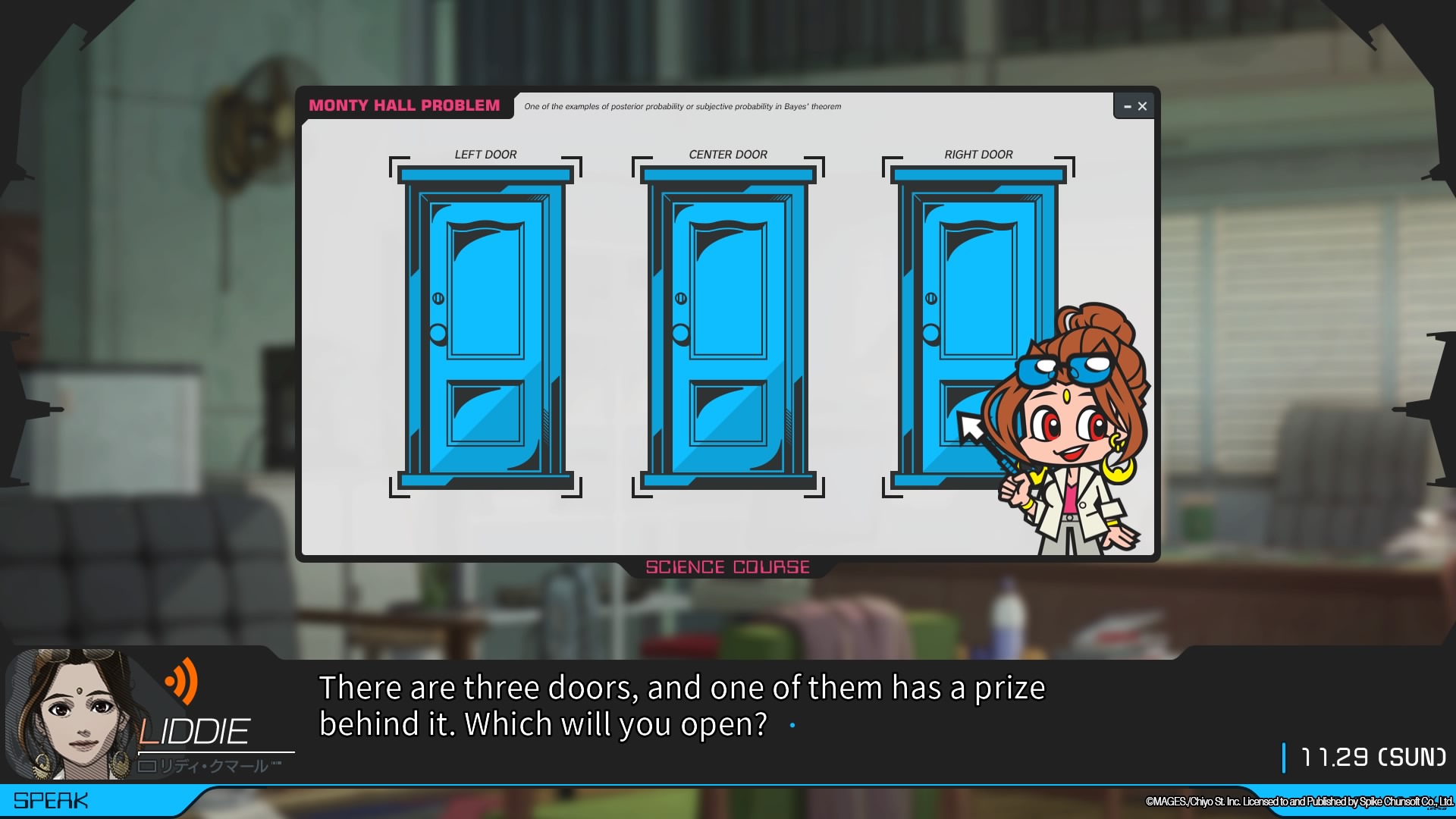
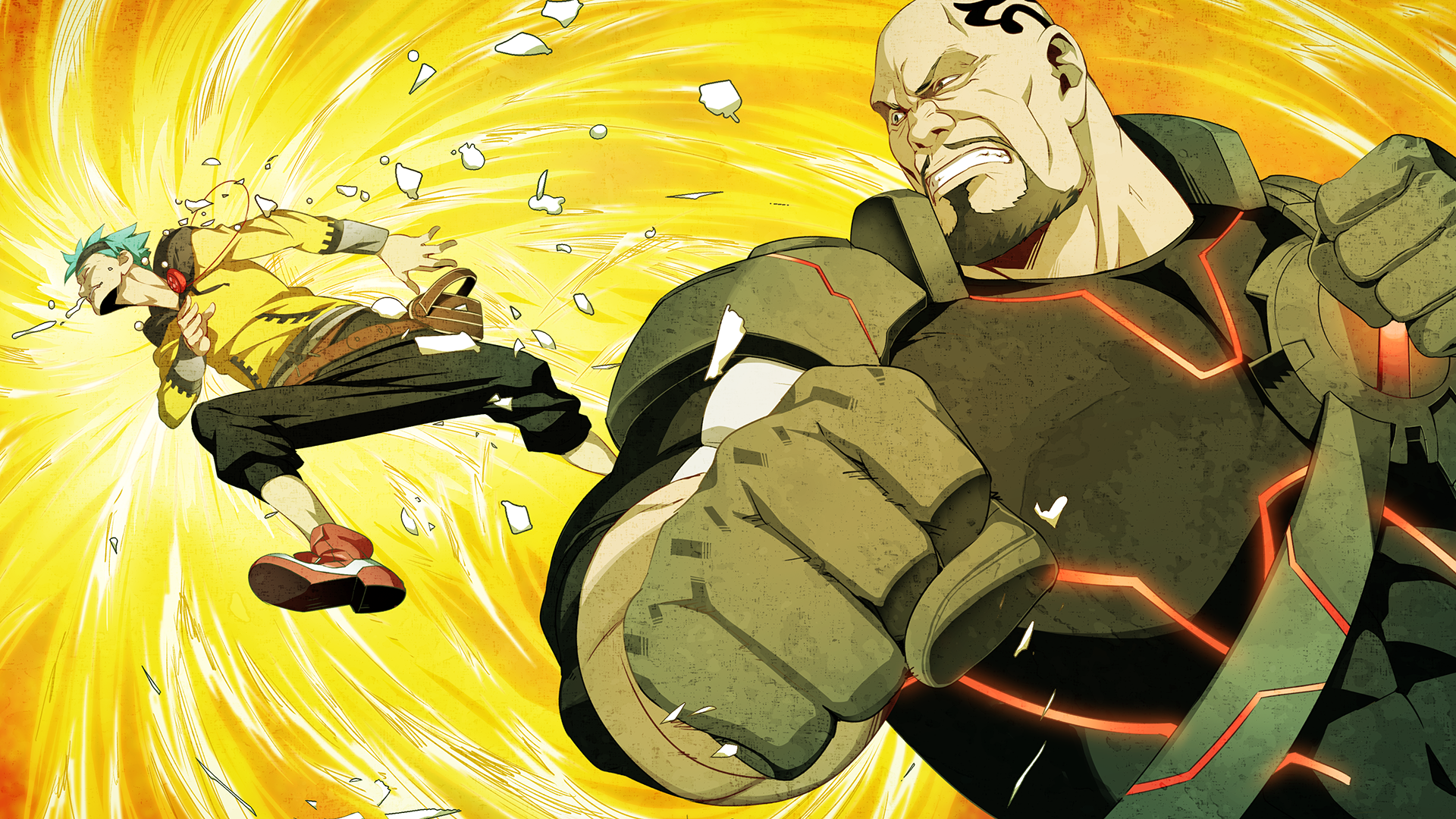
MOVE AND GROOVE
Like ROBOTICS;NOTES before it, ANONYMOUS;CODE aims to evolve the static feel that visual novel characters can have by introducing animated character sprites. As characters speak and think, they will react accordingly. Bambi, while scolding Pollon to operate within the law, will lean in close, her eyebrows scrunched in anger. Momo, when surprised, may bounce backward, her eyes widening and brows shooting upward. Wind, while operating his BMI, will appear to dance in place, grooving to some unheard beat.
ANONYMOUS;CODE’s characters feel alive and reactive to everything that happens around them—it’s evocative, and it works wonders for creating a world that feels active and lived in.
MANGA MANIA
In its most tense, action-packed, or visual scenes, ANONYMOUS;CODE will interrupt its regular visual novel flow to introduce the Manga Trigger: aka, scenes depicted in manga format, complete with its own unique artstyle and sense of motion.
It’s always a nice change of pace to run into these; they help illustrate scenes where there’s a bit more dynamic action to showcase, A treat to watch unfold.
THROUGH MY EYES
In the world of 2037, everyone’s got BMI. No, not body mass index. Short for “Brain-Machine Interface,” it’s technology that interacts with the user’s neural network to allow them to view digital data—search engines, news tickers, images and videos—directly in their vision. Because we (usually) follow Pollon’s perspective, and Pollon is a BMI-user, much of the game’s UI is actually presented through BMI.
Whereas other SciADV are somewhat limited by what information the protagonist seeks out, e.g., STEINS;GATE’s Okabe has to sit down at a physical computer to search up who John Titor was, Pollon can do the same in a matter of seconds without moving a muscle. Better yet, the information that pops up in his BMI can be completely distinct from what’s happening on-screen at the moment. This allows for dual tracks of world-building in the same scene, and that does wonders for the fast pace of the narrative. Pollon can be zooming to his next objective on his gravbike while, at the same time, Wind or Cross are communicating details with him in a real-time call, while a live feed of 4chan hacker comments displays at the side of his vision.
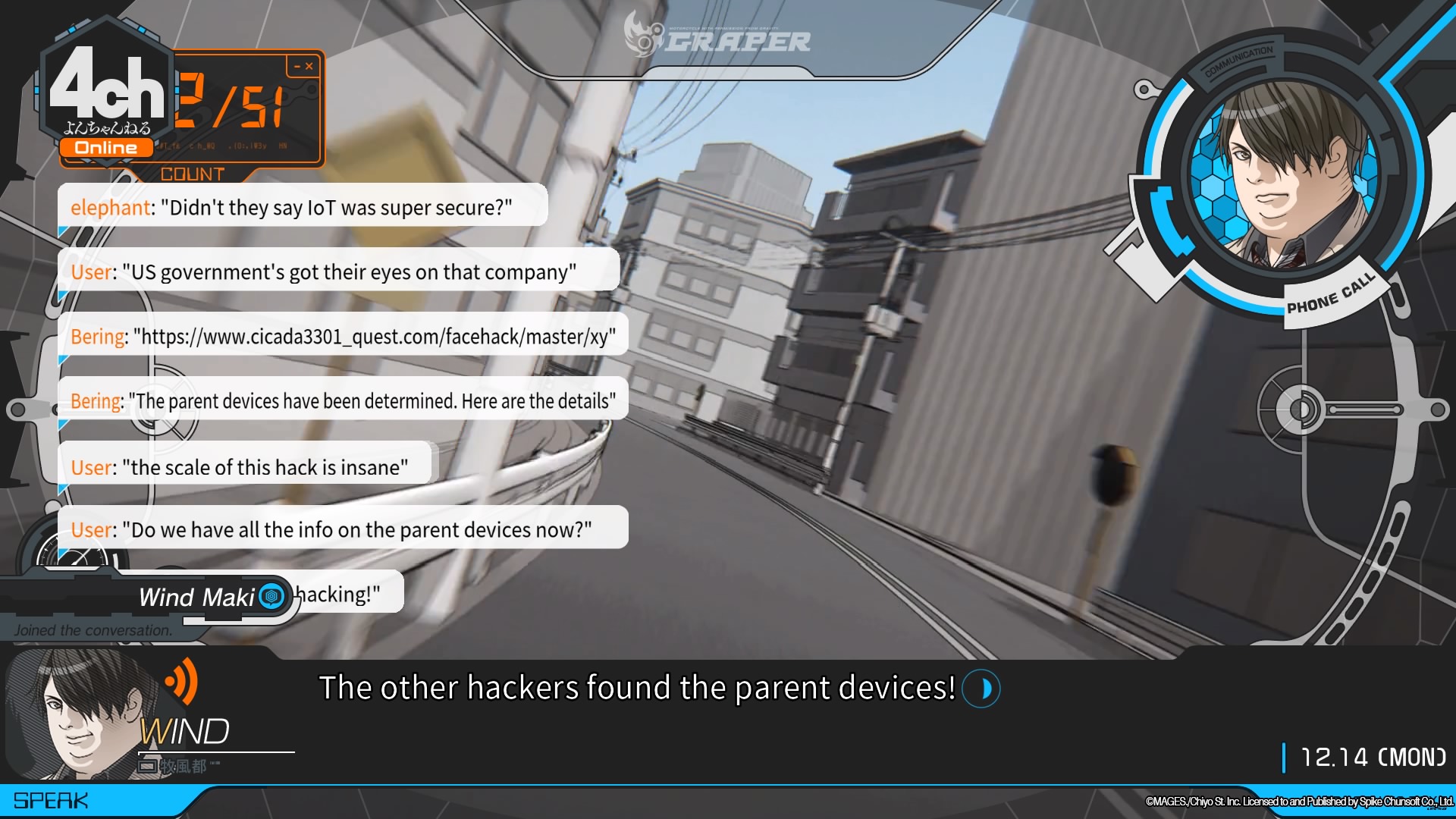
Perhaps the biggest and only downside to the BMI approach is the integration of the backlog. VN readers are probably accustomed to being able to open the backlog to view previous lines of text, in case they need to refresh their memory or reread a line or two. In ANONYMOUS;CODE, the backlog is integrated directly into the BMI of the character whose perspective you are following. Sounds cool, right?
But in third-person perspective scenes—and there are more than a few of these—there is no BMI to actually open a backlog through… so there’s no backlog. Accidentally skipped a line or two? Sorry, either load a previous save, or you’ll just have to keep going. This does get to be a bit frustrating sometimes.
UNEVEN DISTRIBUTION
While on the whole ANONYMOUS;CODE’s visual direction is quite strong, the game still suffers from issues with uneven distribution. The Manga Triggers and CGs are quite nice whenever they do appear, but I can’t help but feel there could have been more of them.
There are certainly narrative moments that would have benefitted from them, that’s for sure. Some critical high-action scenes are unfortunately only expressed with sprites on a background, leaving the rest to your imagination. And while this isn’t necessarily immersion-breaking, when it does happen, the game starts to show its seams. You’ll have moments where a character rushes Pollon down, their sprite leaning forward and bobbing up and down to reflect this; but they don’t actually appear to move closer until you progress a few lines, which has the effect of making it seem as though these characters are just running in place.
Looking through old trailers for this game, you can find a lot of assets that never actually made it into the game, from unused CGs to full-fledged animations with 3D character models. I suppose we just have to assume that, given seven troubled years of development and rewrites, MAGES. had to throw out a lot of perfectly good assets because they didn’t fit the final product. All in all, ANONYMOUS;CODE is still an extremely strong visual experience, but compared to what it could have been, it runs just short of perfection.
MELODIOUS
ANONYMOUS;CODE’s soundtrack is headed, as per usual, by series composer Takeshi Abo. The soundtrack this time is moody and atmospheric: it has its fair share of powerful, in-your-face tracks, of course, but many of its tracks have been crafted to blend in and enhance the scene being read, rather than to stand alone as its own element.
Abo gets full marks for this soundtrack: it’s got a wide range of memorable pieces, subtle and exciting, gradual and breakneck. The way certain tracks blend into each other with increasing tempo and presence is absolute genius. The progression of PROGRAM → OPERATIONS → MINUS STREAM → ACCELERATOR is practically unforgettable.
What’s better than good music? Good music with hidden secrets. The SOUND DATA LOG, included with the digital deluxe edition of the game, features composer commentary for every track in the game: Abo talks about the sorts of scenes they were composed for, his thought processes while composing them, and the hidden meanings held by each. For instance, the chorus in the track ACCELERATOR sings the iconic series phrase, “その目だれの目”—or, “Whose eyes are those eyes?”
Unfortunately, the PC version of the digital deluxe edition does not contain the composer’s commentary. More details in the Guidebook and Soundtrack section of this review.
STRAIGHT SHOT
If you’ve ever been confused or frustrated by the route structure of games like ROBOTICS;NOTES ELITE and STEINS;GATE, I have good news for you. ANONYMOUS;CODE’s structure is incredibly intuitive.
For the most part, the game runs as a straight shot from start to finish—you may encounter a few bad endings along the way, but it’s very easy to figure out how to avoid them. For example, you’ll always have a screen at the end of a bad ending hinting at how to proceed. The game also has a few optional bonus scenes strewn along the way that you can find or miss. If you use our 100% guide to the game, you should have no problem finding all of them and 100%ing the game.
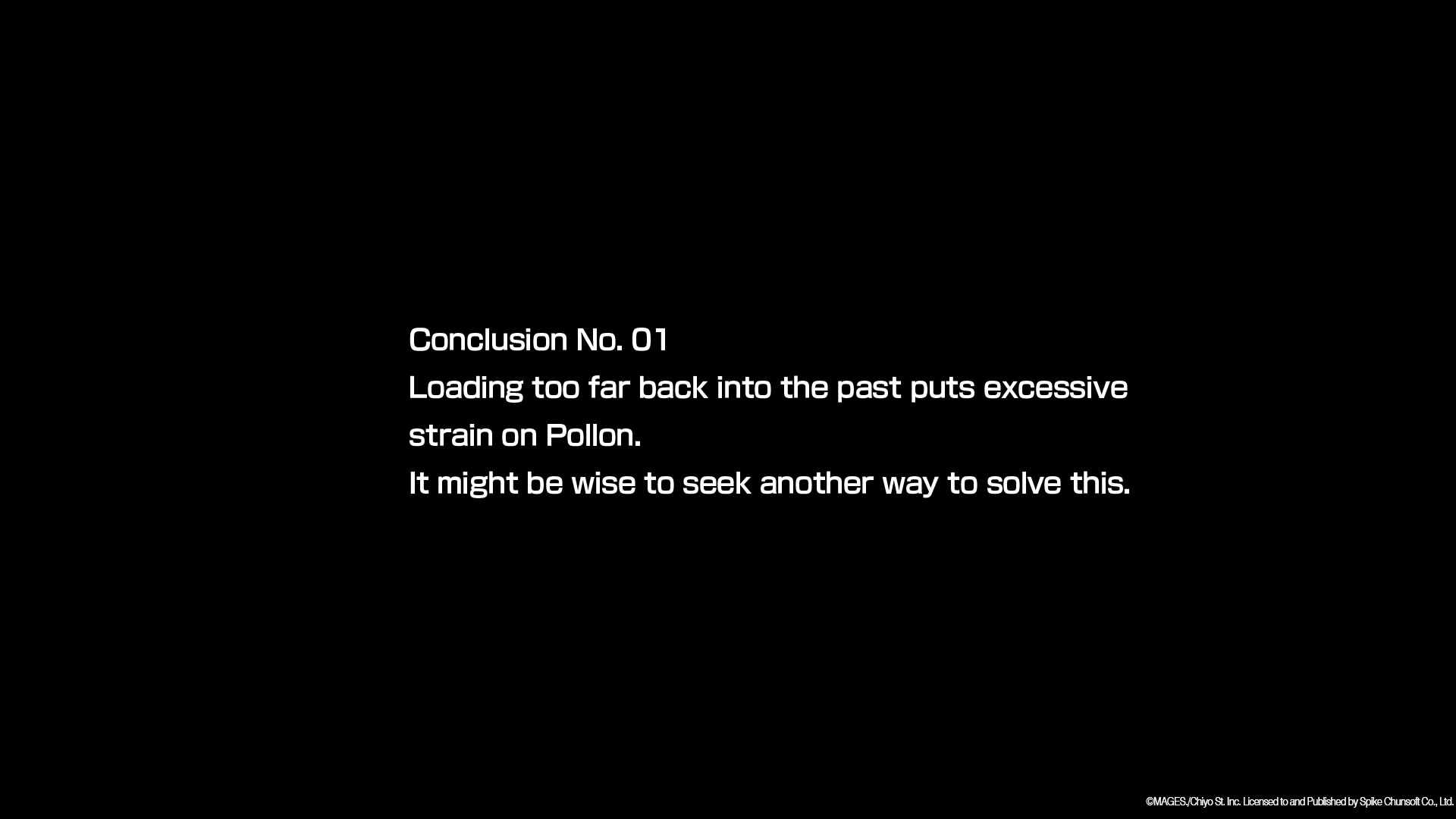
This is going to surprise some longtime fans, but you won’t need a guide to beat this game. No, not even ours. It’s just that simple of a game. In fact, using a guide alongside your playthrough may actually be more annoying than it’s worth, hindering you when you can all but certainly figure out how to proceed in a matter of seconds. So while we have prepared a guide, just know that you won’t need it right away—not unless you really get stuck, or if you’ve already beaten the game and are trying to clean up missed bonus scenes and achievements.
VERSION BREAKDOWN
PLAYSTATION 4 & 5
The majority of our review period was spent playing the PlayStation version of the game. On the whole, this is probably the most optimal and issue-free version of the game. Presented in full 1080p, the game is gorgeous and functions virtually perfectly. The English release does suffer from a few oddities, however:
- A bug appears to cut off longer TIP entries past a certain point, though for the most part, you should be able to read the grand majority of every TIP—this is a rare issue.
- We also noted that the video quality of the opening song movie is a bit lower than expected, displaying artifacting where the original Japanese release did not.
- Finally, we found that a very small handful of voicelines in the game play a bit louder than intended—they might give you a bit of a jump, but they shouldn’t hurt your ears unless you were already playing at a higher volume.
We’ve communicated these issues to Spike Chunsoft and hope to see them addressed in the future. Aside from these few problems, the PlayStation 4 version of ANONYMOUS;CODE is in excellent shape and should pose little to no problems for the average reader. We’ve additionally tested the game on PlayStation 5 and can confirm it plays flawlessly there.
NINTENDO SWITCH
The Nintendo Switch edition of the game is a great choice for players who want to read on the go or in bed, as well as on a TV, but some compromises have been made in the process.
The game itself is presented in 720p regardless of if you are playing in portable mode or on a higher-resolution display. In a few scenes, this can result in visibly low visual quality or pixelation. Some minor performance issues may occur, though for the most part, they are difficult to notice and should not interfere with your experience.
- Like on PlayStation, the opening song in the Switch version shows artifacting and is generally in poorer quality than in the Japanese version of the game.
- Like on PlayStation, longer TIPs can also appear cut off here, though the issue is actually somewhat less prominent than in the other versions of the game.
As with the PlayStation version, we’ve communicated these issues to Spike Chunsoft and hope to see them addressed in the future. All this aside, ANONYMOUS;CODE on Switch is generally in good shape. The game supports single Joy-Con play, which is nice for when your hands need a rest.
PC VIA STEAM
The PC version on Steam of this game is in an odd position where it’s both well put-together, but also faces a few odd issues the other versions don’t.
The goods: you can actually navigate most of this game with just your mouse. The PC version of the game adds a few additional, clickable UI elements to access the pause menu, backlog, auto, and skip modes. And yes, just to be clear, there is mouse support. You’ll still need your keyboard sometimes—to exit the game, for example, you still have to press Esc—but the QoL they’ve implemented for this version of the game is generally quite excellent.
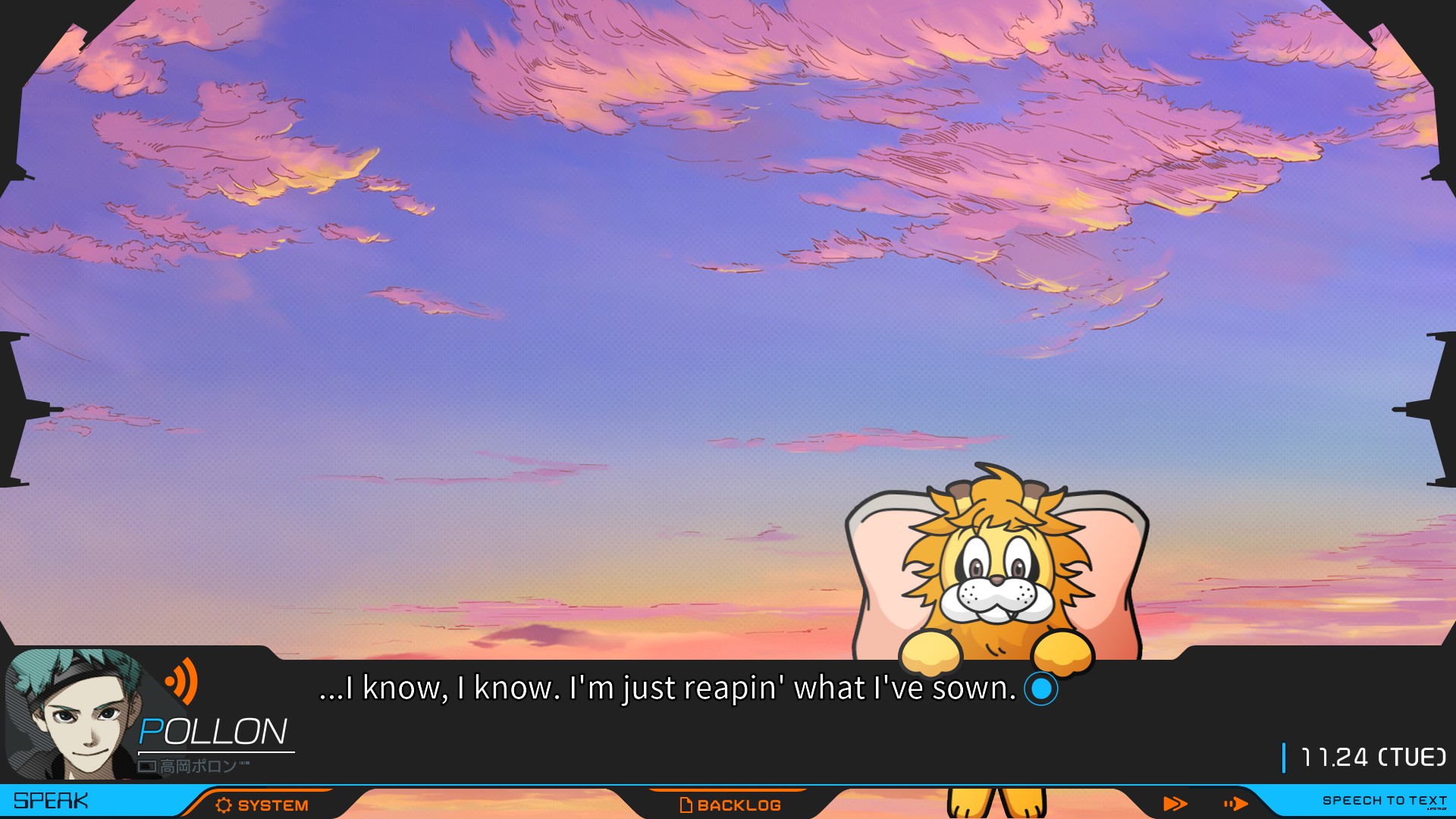
Graphics-wise, ANONYMOUS;CODE is similar to the PlayStation version, capable of 1080p display but also being playable at 1280×720 and 1024×576 resolutions.
Still, there are downsides. Not all of the game’s key bindings are intuitive; for instance, you need to press the “1” key to open the pause menu via keyboard, and if you’re not playing with a controller, you might find that you’ll actually need to use this obscure key binding at certain points in the game where the UI isn’t available.
While you can switch between windowed and fullscreen mode with the F11 key, you won’t have any options to adjust the resolution while in game—that, you’ll need to do within the launcher, which I can see causing a few minor annoyances.
- Our testing revealed that, on many NVIDIA graphics cards, the way the text renders on-screen may slightly bug out, resulting in the occasional abnormal-looking letter or two every so often.


- We also found that the game’s opening song played in extremely poor audio quality and notably higher volume compared to the rest of the game.
- Additionally, one prologue movie is missing background music, whereas on console versions this issue is not present.
- Finally, the TIPS cut-off issue found in the other versions of the game is also present here.
We’ve communicated these bugs to Spike Chunsoft and hope to see them addressed in the future. Aside from these issues, the PC version is generally in good working condition and functions quite similarly to the PlayStation version of the game.
STEAM DECK
We caught a lucky break back when CHAOS;HEAD NOAH launched on Steam, since it pretty much worked out of the box on Steam Deck. Unfortunately, ANONYMOUS;CODE may require a bit more work. On a regular launch, character voicelines and various sound effects do not play as intended, and the game is quick to crash a few lines into the story.
Since the port was not built to support Linux, obviously it was always going to be a bit of a gamble as to if it would function there. Here’s hoping community tinkerers may be able to figure something out.
(Distros tested: SteamOS, Arch Linux)
GUIDEBOOK AND SOUNDTRACK
Spike Chunsoft also graciously provided us the opportunity to review the ANONYMOUS;CODE Digital Deluxe Edition contents on Nintendo Switch and PC—i.e., its guidebook and soundtrack—and that’s what I’ll close out this review with.
At $80, or $20 above the standard edition’s price, the digital deluxe edition nets the player the main game, an additional guidebook, and a complete soundtrack of the game. The cool thing about this is, these are actually the same limited edition contents the Japanese console release received last year. Although we sadly didn’t get these physically like Japan, it’s rare that an English SciADV release can claim to have content parity with its Japanese release. I for one hope this trend keeps up. It’s a treat.
The guidebook, A BEGINNER’S GUIDE TO EARTH SIMULATOR, is, as the name implies, structured as a beginner’s guide to the GAIA Earth Simulator, a facet of ANONYMOUS;CODE’s world that plays a key role in the narrative. It’s narrated from an in-universe perspective and plays a few roles: it introduces you to the game and its systems, gives you a glimpse at the characters, technologies, and world, offers a handful of lore insights, and shares comments from some of the creatives involved in the game’s production.
It’s not a particularly long guidebook—you can probably read through it an hour, whether you choose to before or after you finish the game. Still, it’s definitely a step up in terms of content and value, at least compared to other similar digital artbooks and guidebooks. I’d give this guidebook my highest recommendation to those SciADV fans who are passionate about the series and want to further engross themselves in the worldview of ANONYMOUS;CODE.
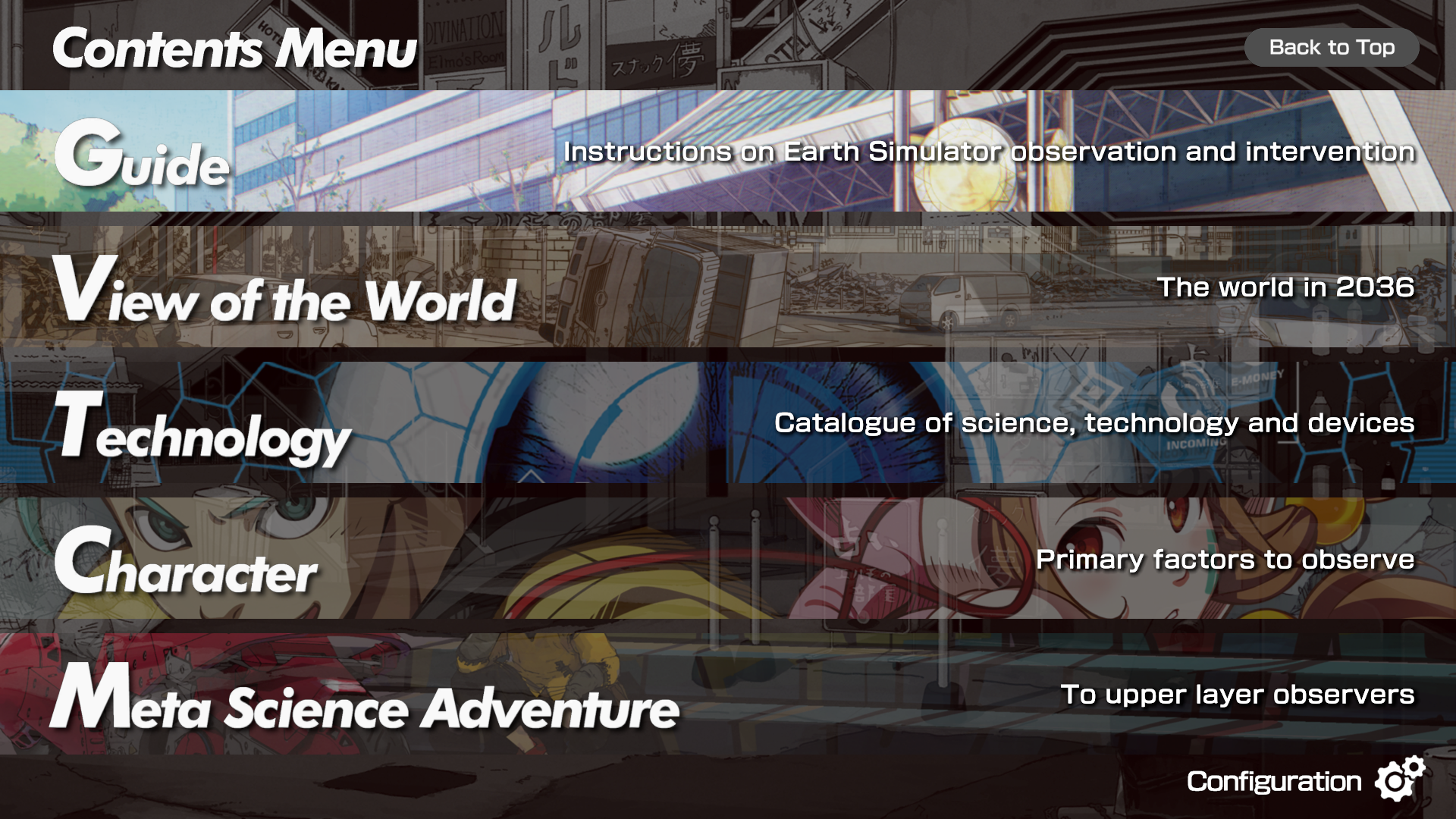
The soundtrack, SOUND DATA LOG, is a nice addition too, albeit it’s got a caveat on PC. On Nintendo Switch, the soundtrack, like the guidebook, is a separate app. It allows you to listen to each and every Takeshi Abo composition found in the game, and as a bonus, there are English translations of his composition comments available in the app. These will give you insights into his thought processes, intentional choices, and interesting fun facts about each of ANONYMOUS;CODE’s background music tracks. The app itself is pretty simple on Switch, though for some reason it’s only navigable with an on-screen mouse you control with the analog stick. Otherwise, it functions as it should.
Steam players, on the other hand, are a bit out of luck. If you choose to purchase the Digital Deluxe Edition on Steam, it seems you will receive the full soundtrack—it becomes available through Steam’s dedicated music player, and you can also find the files in your Steam install folder—but what you won’t get is the soundtrack app, and therefore, Abo’s composition commentary.
On the bright side, buying SOUND DATA LOG on Steam means the soundtrack isn’t tied to a console. If you browse to your steamapps/Music folder, you can find the soundtrack in both MP3 and FLAC, and you can copy that to your other personal devices for listening on the go or off your computer.
IN SUMMARY
I’ve come away from ANONYMOUS;CODE stunned. The SciADV series is back, and it’s better than ever. ANONYMOUS;CODE is, in pretty much every respect, one of the best Science Adventure games, if not one of the best sci-fi visual novels on the market right now. It simply succeeds where it must, and its successes are sublime.
I don’t think anyone knows where the series is going to go from here, but one thing’s for sure: this is a step up and a step forward. The future of SciADV looks exciting, and I can’t wait to see more of what it has in store for us.
9/10
ANONYMOUS;CODE is, in all respects, a confident and strong step forward for the SciADV series. Its story, characters, and presentation are reminiscent of what made the classic games exceptional, while still boasting modern innovation galore. Likewise, its English localization is accomplished on virtually all fronts.
A few smaller issues, like bugs, problems with accessibility, and its price point hold the game back from perfection, but if you’re willing to look past these gripes, ANONYMOUS;CODE is a masterpiece that ought not to be missed.
ANONYMOUS;CODE will launch on PlayStation 4, Nintendo Switch, and PC via Steam on September 8, 2023 in North America and Europe. Physical preorders for an exclusive SteelBook edition are currently available through various retailers; digital eShop preorders are available on console at a 10% discount for Switch and PlayStation, while a launch week discount is planned for Steam.
A Digital Deluxe Edition will also launch on September 8, and will feature an exclusive guidebook and full game soundtrack.
To learn more about this upcoming release, be sure to check out the ANONYMOUS;CODE official website.
